Wine, History, Culture:
11 Days: October 13 - 23, 2024
Accommodation: 10 nights:
Night 1: Sunday, October 13Grand Hôtel des Terreaux in Lyon, a 4 star, beautiful hotel in the heart of Old Lyon, the Unesco World Heritage site. It combines the atmosphere of an old-fashioned 19th century town house with a modern, innovative décor. It also has an interesting indoor pool and hot tub. |
Nights 2 + 3: Monday, October 14 + Tuesday, October 15Hôtel Fac & Spera in Tain-Hermitage, a 4 star fitness and spa hotel – just beautifully renovated - belonging to Maison Chaputier situated in the center of town at the foot of the famous Hermitage vineyards and just 200m from the banks of the Rhône river. |
Nights 4 + 5: Wednesday, October 16 + Thursday, October 17Hôtellerie du Domaine De Cabasse, a 3 star just recently completely renovated hotel is part of the wine estate Domaine De Cabasse. The view up to the village of Séguret clinging to the rugged mountain behind the domaine is breathtaking. The calm atmosphere and the great outdoor swimming pool hidden in a quiet garden surrounded by vineyards gives it a true Provençal feeling. |
Nights 6 + 7: Friday, October 18 + Saturday, October 19Hôtel Le Mas de L’Ouliviés in Les Baux, a 4 star traditional Provençal country style resort hotel sitting in the center of an olive grove at the foot of the rocky, steep slopes of the village of Les Baux de Provence. The beautifully landscaped pool invites for a relaxing swim. |
Nights 8 +9: Sunday, October 20 + Monday, October 21Hôtel Mercure, Pont d’Avignon in Avignon, a 4 star very modern hotel in an ideal location. The famous sites – the Pont d’Avignon and the Palais des Papes as well as restaurants, shops, wine bars, the city wall, are just steps away. |
Night 10: Tuesday, October 22Hostellerie Château des Fines Roches in Châteauneuf-du-Pape, a 5 star exquisite castle hotel. Approaching the hotel takes your breath away. The medieval and provencal fantasy style castle was built in the 19th century. It sits high on a hill overlooking the Châteauneuf-du-Pape vineyards, with gorgeous views to the towns of Châteauneuf du Pape, Avignon, and as far as to the Luberon. |
DAY 1: Sunday, October 13 |
MORNING / EARLY AFTERNOONArrival in Lyon, check-in at Grand Hôtel Terreaux.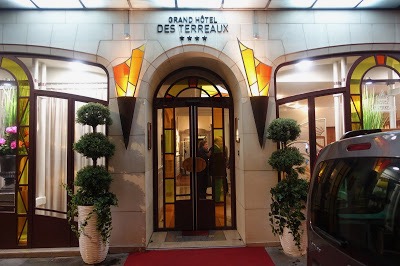
Welcome coffee and meet & greet in the Grand Hôtel des Terreaux in Lyon. |
AFTERNOONWe take a walk across the Saône river bridge to the Renaissance part of Old Lyon to visit the Antic Wine store. |
|
|
|
Georges Dos Santos, owner of Antic Wine and well-known as the flying Sommelier provides us with a tasting of wines from the different Rhône Valley regions. This will be a perfect introduction to the many Rhône grape varieties and appellations. |
EVENINGDinner with a “bouchon” wine at "Chez Paul".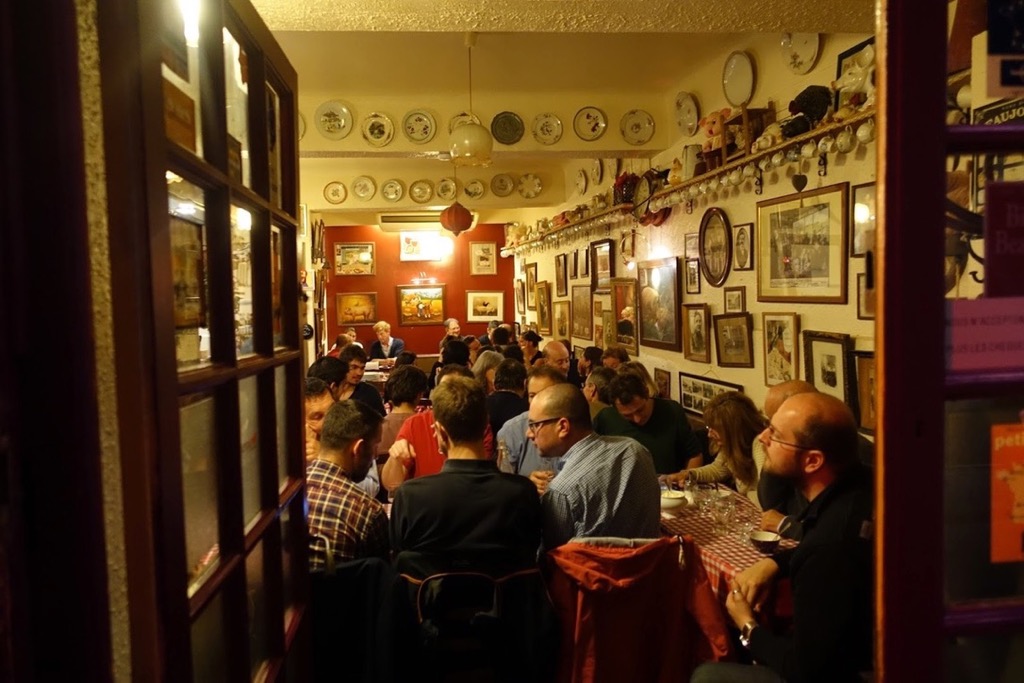
A “Bouchon” only serves one traditional Lyonnais menu and very often the bowls are passed around for everyone to take what he / she likes. Le Bouchon Chez Paul is one of the highly regarded traditional Bouchons and every night it is full to the brim with mostly local folks enjoying the evening. |
DAY 2: Monday, October 14 |
MORNINGVisit and tasting at Maison Guigal in Ampuis, Côte Rôtie, Northern Rhône.
The Guigal Estate is a family business and was founded in 1946 by Etienne Guigal. Etienne Guigal worked at Vidal Fleury before establishing his own domaine. Much later in the 1980s Vidal Fleury was acquired by Guigal, but remains independently managed. Today Maison Guigal is run by Philippe Guigal, the third generation of the family who also is the head winemaker. Through carefully selected acquisitions Guigal grew and today the total vineyard holdings is around 120 acres of which half of it is in the Côte Rôtie. The estate also acquired the famous Château d’Ampuis, an important historic and oenological monument whose long history – an ancient fort built in the 12th century- is directly linked to the Côte-Rôtie appellation. The Château sits majestically on a hill surrounded by vineyards overlooking the Rhône river. With a current production of 6,5 million bottles Guigal is also the most important négociant in the Northern Rhône, although the majority of the purchased fruit comes from the Southern Rhône. Marcel Guigal, the second generation is credited with the biggest impact on the quality of the Northern Rhône wines when he introduced single vineyard cuvées from Côte Rôtie in the 1970s. Maison Guigal has the rare distinction of being a quality leader in both estate and négociant wines. |
Drive through the vineyards of the Côte Rôtie.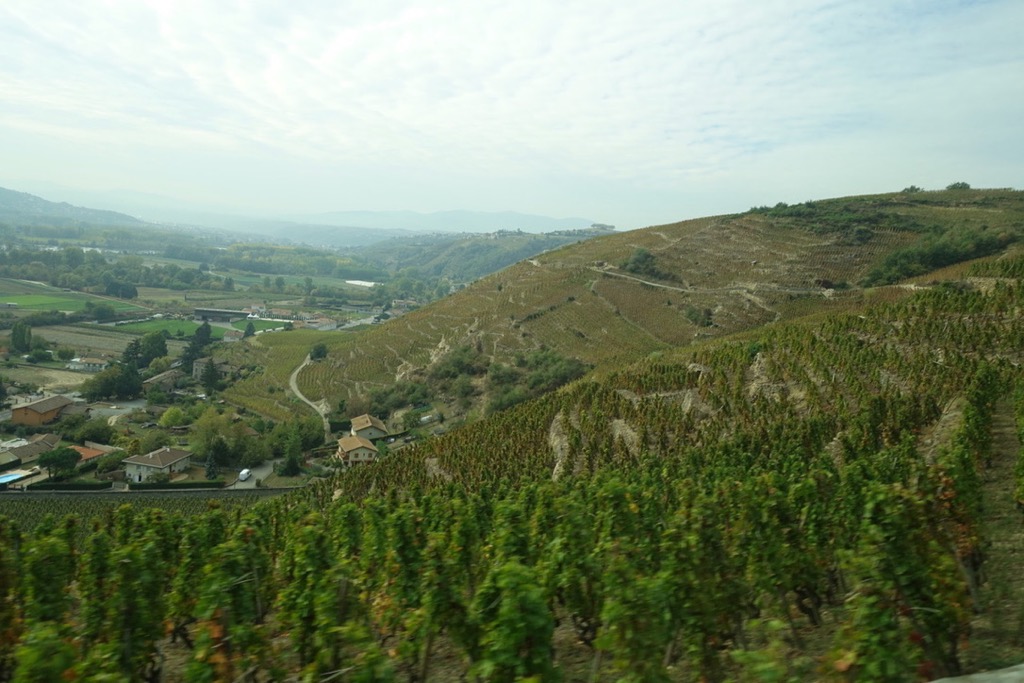 To provide you with a feel for the Côte Rôtie we will take a trip through the vineyards to see the Côte Blonde and Côte Brune as far as our bus can negotiate the winding roads and hairneedle bends. To provide you with a feel for the Côte Rôtie we will take a trip through the vineyards to see the Côte Blonde and Côte Brune as far as our bus can negotiate the winding roads and hairneedle bends. |
LUNCHLunch (beverages on your own) at the Bistro de Serine in Ampuis.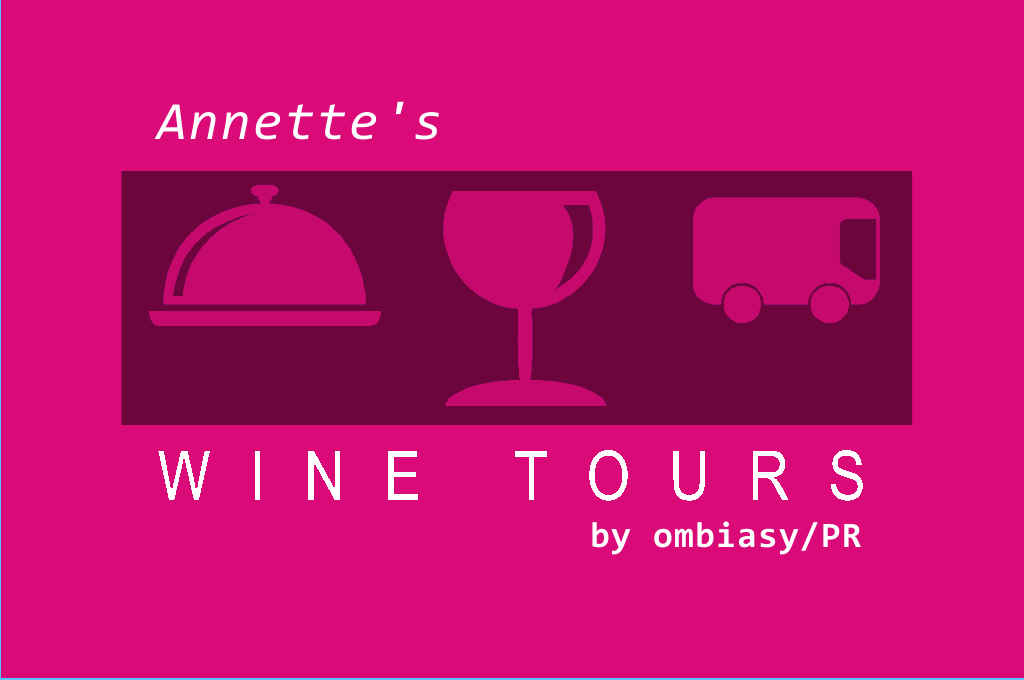
This is a simple village lunch hang-out for locals and the occasional tourist alike. The owners also have a wine store next door with a fabulous selection of Rhône wines. |
AFTERNOONVisit and tasting at Domaine Ogier, Northern Rhône.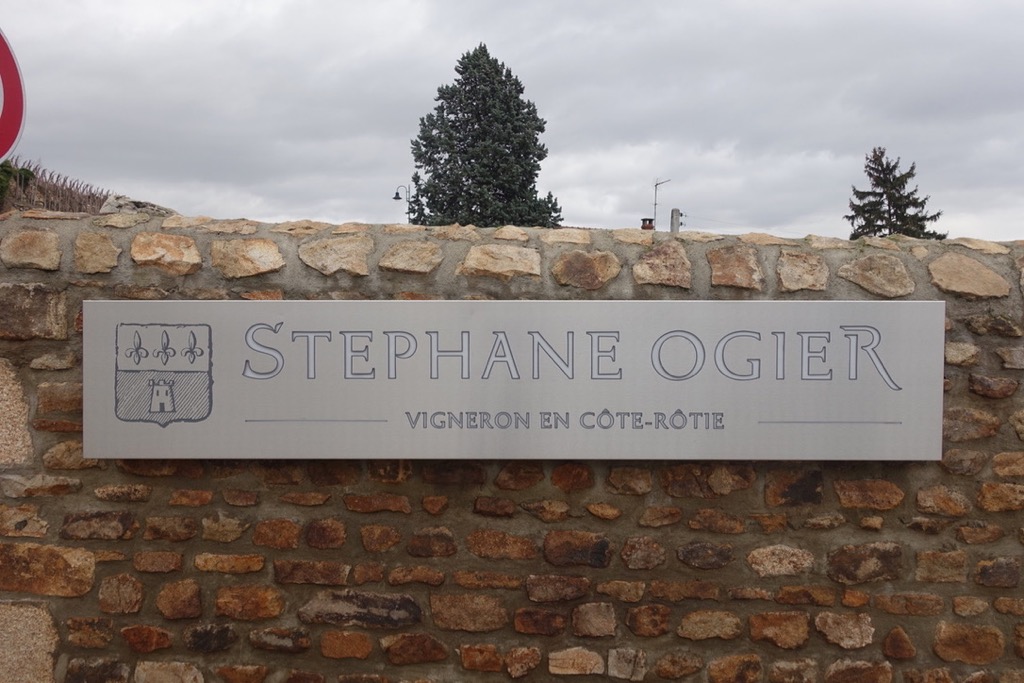
Located in the midst of the most iconic wine communities of the Northern Rhône, this Domaine has vineyards in the top of the top locations. The domain is the oldest still existing wine estate in Chavanay, a tiny hamlet between Condrieu and Saint-Joseph. The history of the estate can be traced back to the 14th century. It was in 1797, after the French Revolution when the Domaine |
EVENINGArrival and check-in at Hôtel Fac & Spera in Tain-l’Hermitage.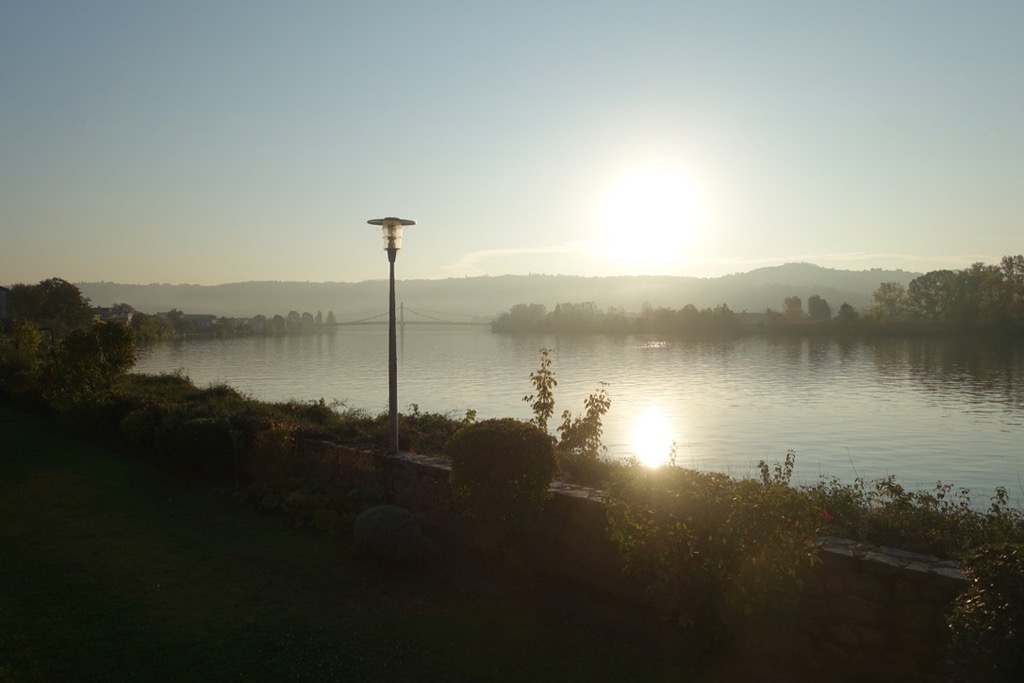
The hotel sits right in the town center of Taim-Hermitage on the banks of the Rhône river. |
Gourmet Dinner with matching wines at restaurant Beau Rivage.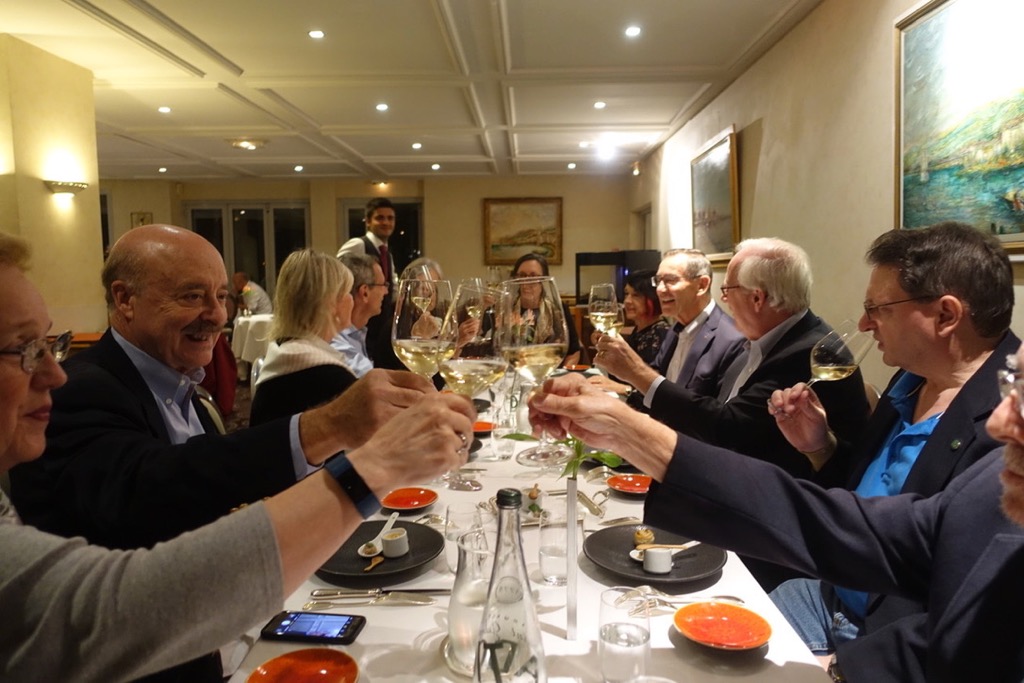
Chef Ludovic Mounier is well known beyond the boundaries of the Northern Rhône. This elegant restaurant features an innovative cuisine with classic top regional products. |
DAY 3: Tuesday, October 15 |
MORNINGVisit and tasting at Maison Delas-Frères in Saint Jean de Muzols – Saint Joseph, Northern Rhône.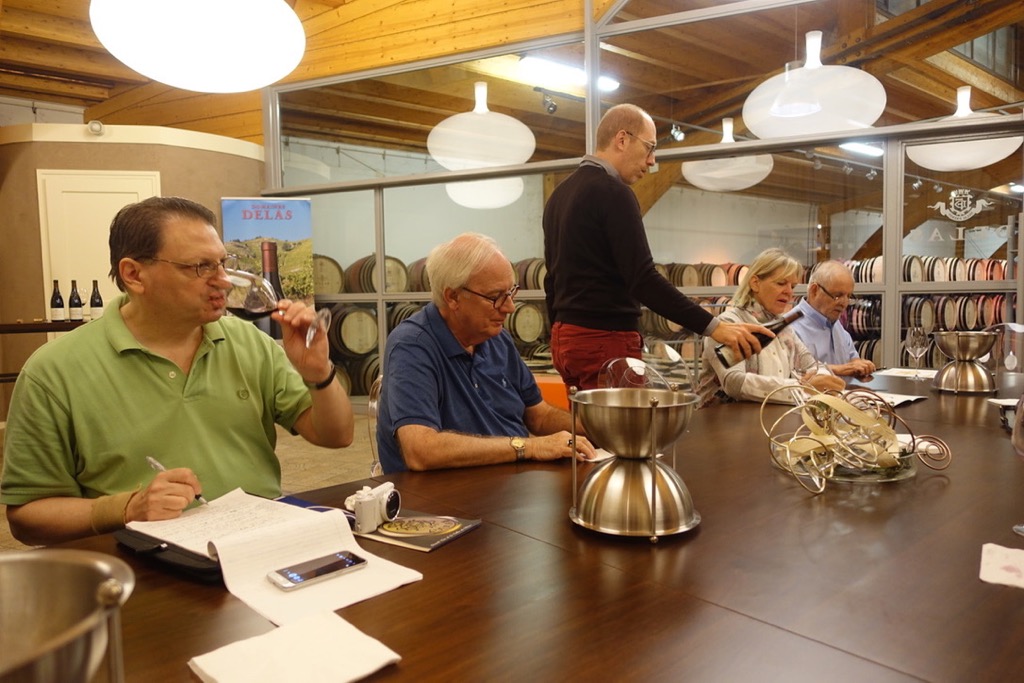
Delas-Frères is one of the top producers of the Rhône in a myriad of appellations with holdings in the Côte Rôtie, Saint Joseph, Saint Péray, Hermitage, Crozes Hermitage, Cornas and Condrieu in the Northern Rhône as well as in the Southern Rhône in Châteauneuf du Pape. The company also produces one of the top value wines from the region with their Côte du Rhône. Delas-Frères can look back on one of the longest history in the region. It was founded in 1834 as a négociant house. In 1977 Delas-Frères was acquired by Champagne Deutz. When Deutz was purchased by Roederer in 1993 Delas-Frères came under the ownership of Champagne Roederer. About half of the production of 1,5 million bottles comes from the 75 acres of Domaine vineyards; the other half comes from purchased grapes. Many bottlings of the Domaine production are labeled as Domaine des Tourettes. |
LUNCHLunch (beverages on your own) at restaurant La Grappe d'Or in Saint-Péray.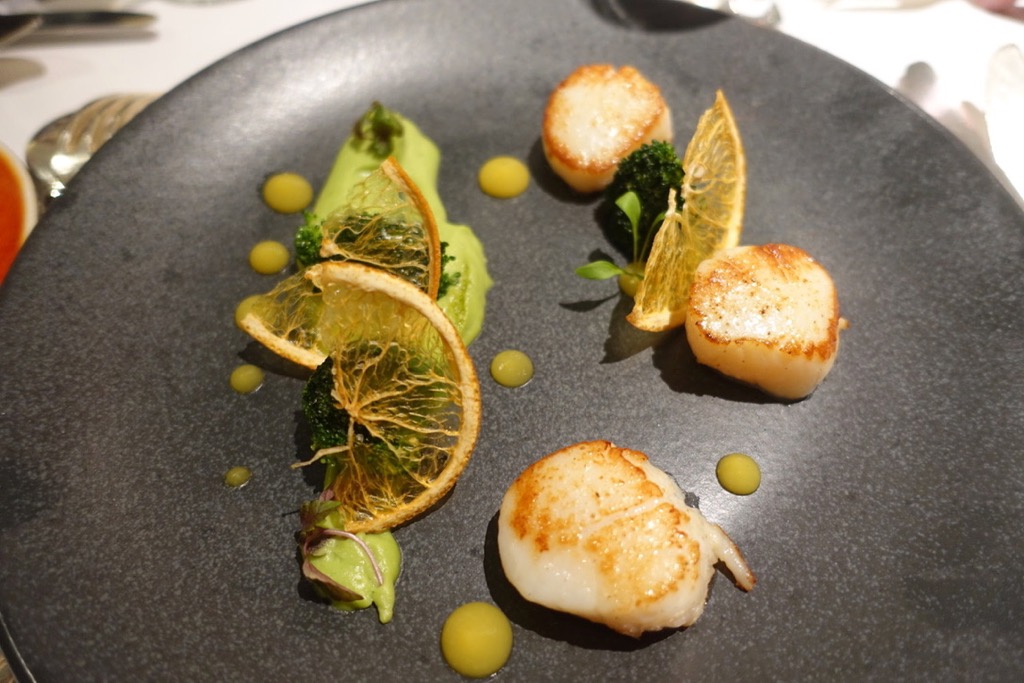
This is a gem of a restaurant, a small, unique place that serves a delicious, excellently prepared lunch menu. The wine menu is attractive with a great selection of local wines. |
AFTERNOONVisit, and tasting at Domaine Jean Luc Colombo in Cornas, Northern Rhône.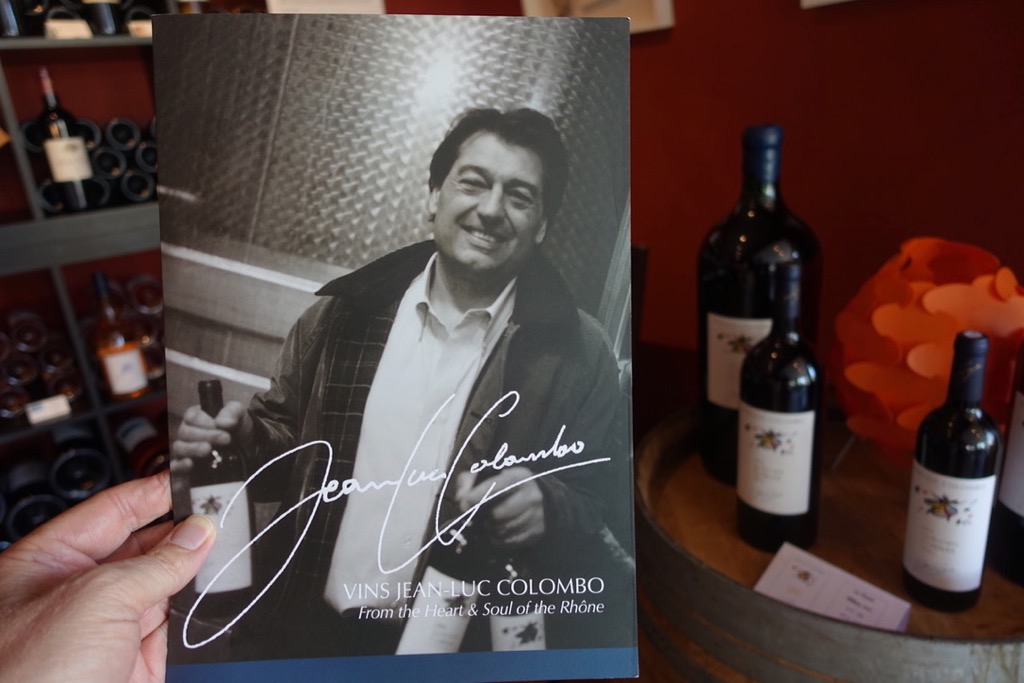
This is a relatively young winery by French standards, established in 1987. Today Jean-Luc Colombo is one of the most progressive and influential winemakers of his generation and is nicknamed “The Winemaking Wizard of the Rhone.” Jean-Luc, a native of Marseille, moved with his wife Anne to Cornas in 1982 to set up a pharmacy and oenology lab. Both are oenologists and they created the “Centre of Oenology of Côtes du Rhône” in Cornas in 1984. Jean-Luc has ever since been a consulting winemaker for some 100 of the best “Domaines” in the Rhône Valley, Provence and Bordeaux.In 1993 Anne and Jean-Luc sold the pharmacy to focus only on wine. They purchased more vineyards and started to work as négociants in the region. The Domaine now has 30 acres of vineyard holdings in Cornas. The bulk of the entire production is through the négociant business, with around 30 wines, the biggest line being the Côte de Rhône. |
Visit, tasting, and vineyard walk at Paul Jaboulet Aîné in Tain-l’Hermitage. Hermitage, Northern Rhône.el.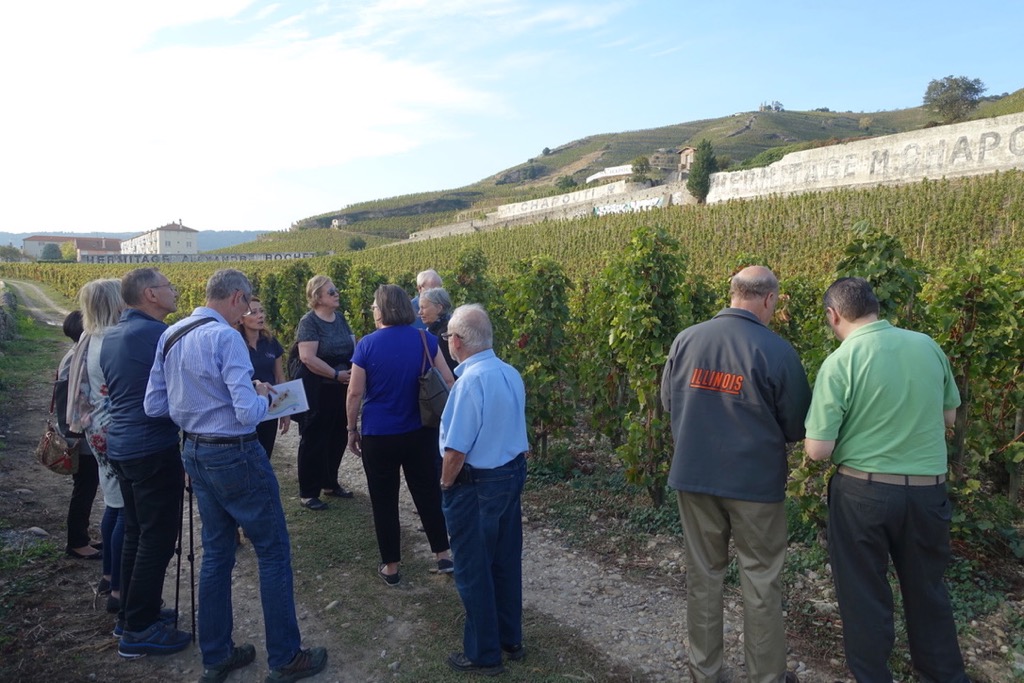
Paul Jaboulet Aîné is the smallest of the big négociants businesses of the Rhône region. Jaboulet is a great old name and one of the historic estates in the Rhône. Exactly 100 years before the AOC system was established, in 1834 Antoine Jaboulet began to transform a sleepy region into one of the most important wine regions of the world and Jaboulet has since become a benchmark in the Northern Rhône. The iconic vineyard site “La Chapelle” visible from afar because of the chapel in the middle of the vineyard high on the Hermitage hill belongs to Jaboulet. We will drive up the Hermitage hill to get a close up look at the famous “La Chapelle”. In 2006 the Frey family, owners of Château La Lagune in the Médoc, acquired Paul Jaboulet Aîné. Since then the Freys have started a forceful expansion, increasing the domaine vineyard sites to almost 300 acres with purchases in the Northern Rhône as well as in Châteauneuf du Pape. Winemaker Caroline Frey also started converting the domaine vineyards to biodynamic principles and encouraged the growers they buy grapes from to convert to organic or sustainable vineyard management. Jaboulet wines belong once again to the best of the Rhône Valley wines. |
EVENINGHôtel Fac & Spera in Tain-l’Hermitage.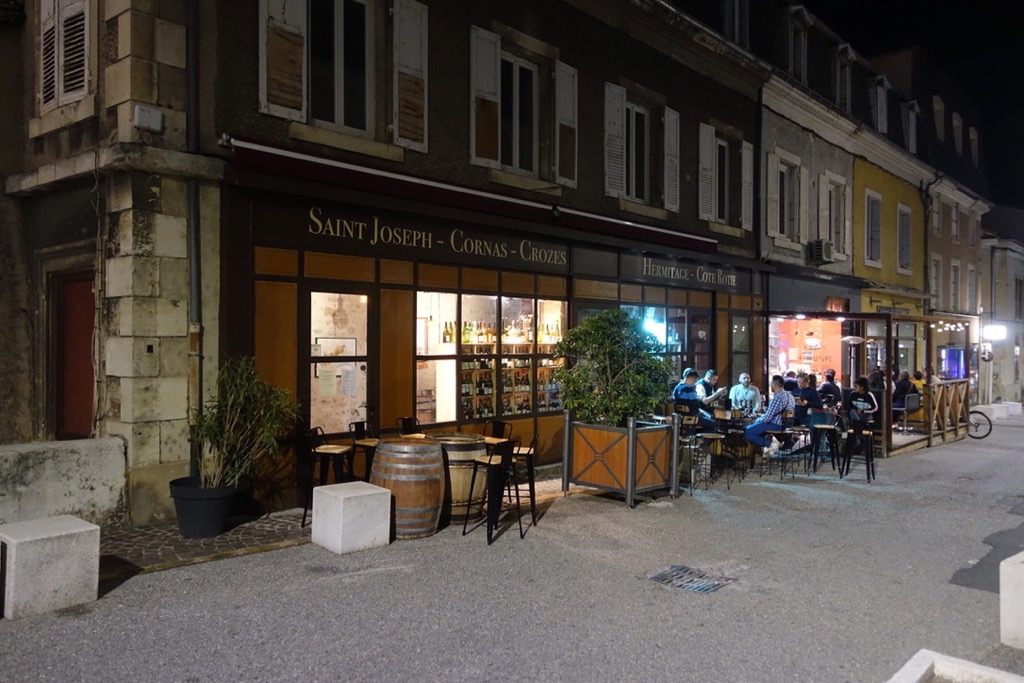
This hotel sits in the center of Tain-Hermitage and is in walking distance to everything. |
Evening and dinner on your own.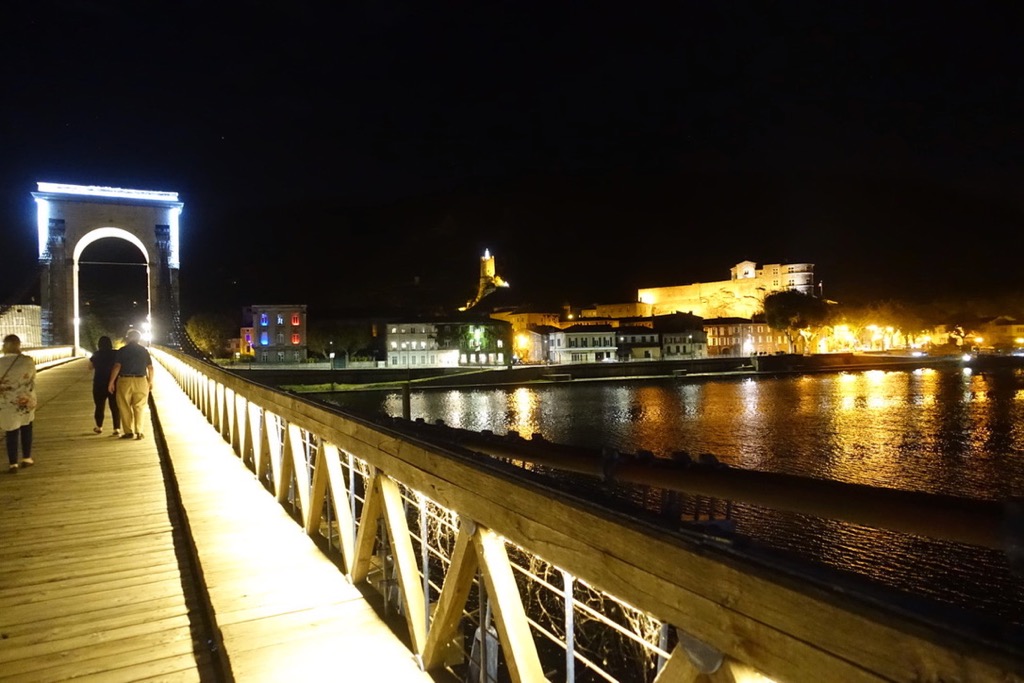
Stroll along the banks of the Rhône river, cross the bridge to walk to Tournon-sur-Rhône on the other side of the Rhône. From there you have a fantastic view of the hills with the Hermitage and Crozes Hermitage vineyards. |
DAY 4: Wednesday, October 16 |
MORNINGCellar tour and tasting at Domaine Laurent Habrard in Gervans, Crozes-Hermitage, Northern Rhône.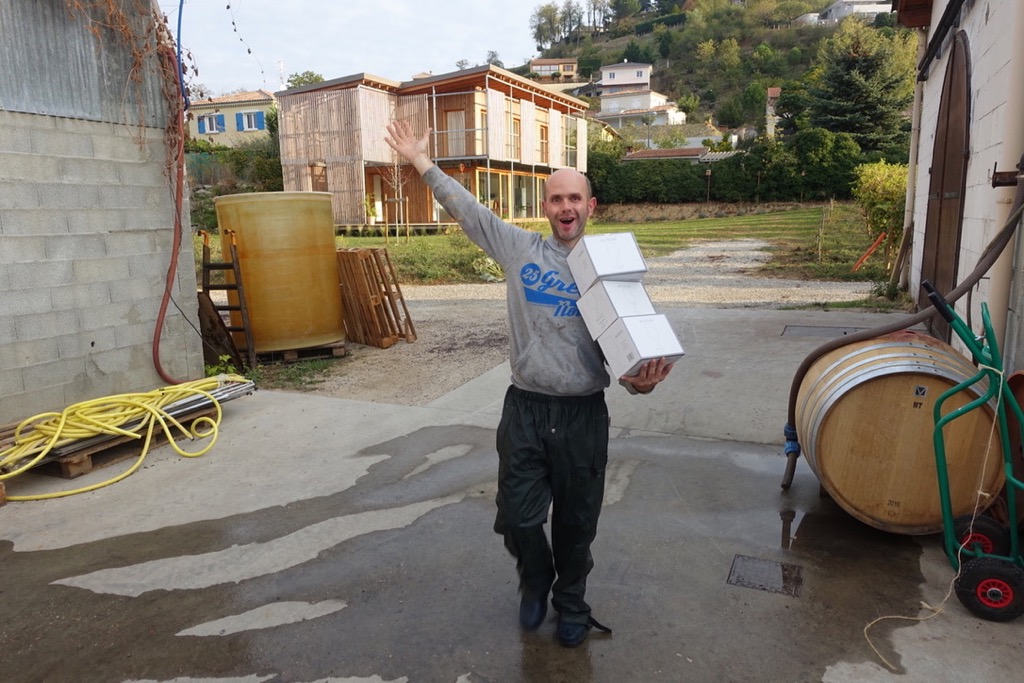
Current owner, manger, and winemaker of this 45 acres domaine is Laurent Habrard, 5th generation of the Habrard family who has been building up the winery in Gervans at the foot of the Crozes-Hermitage hill. In 2008 Laurent started to convert to organic viticulture. Since 2011 the estate is certified organic and since 2013 the domaine no longer uses SO2 during vinification. None of his wines see new wood, as he has been transitioning away from old barrels to concrete tanks. The Crôzes-Hermitage Rouge is made from 100% Syrah from vines grown in the vineyard ‘Les Chassis’ in the commune of Pont de l'Isère and also the communes of Gervans and Erôme. Laurent's vines are old, the Syrah averages 40-60 years of age. In general all Domaine Habrard vineyards are mature with an average of over 40 year old vines. |
Winery visit and tasting at Domaine Les Bruyères in Beaumont-Monteux, Northern Rhône.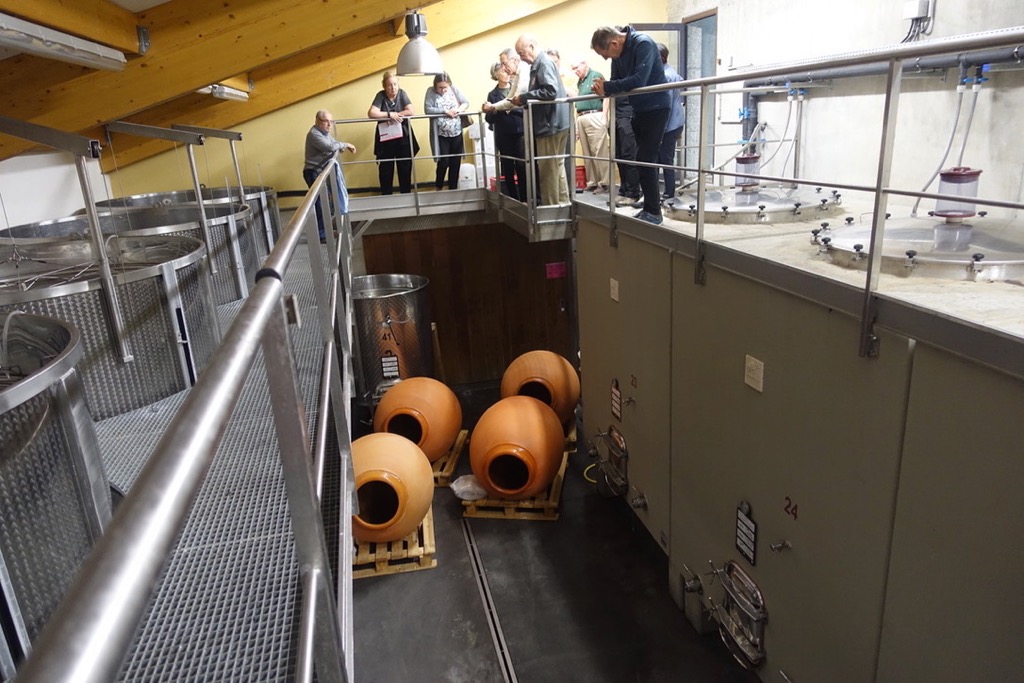 Domaine Les Bruyères has been in the Reynaud family since the 18th century. In 1955, Georges Reynaud planted vines on a gentle slope along the Isère River –a Rhône tributary - in the southern sector of the Crozes-Hermitage appellation. The grapes were sold to the cooperative. In 2003 George’s grandson David took over. He constructed modern wine making facilities, and produced his first vintage. He also bought new vineyards bringing the domaine up to 50 acres under vine. Before his ownership in 2003 David already controlled the domaine and had started to farm organically, so the domaine was certified by Ecocert the same year as his first harvest. He then converted slowly to biodynamic principles and Domaine Les Bruyères received its Biodyvin certification in 2005. Domaine Les Bruyères has been in the Reynaud family since the 18th century. In 1955, Georges Reynaud planted vines on a gentle slope along the Isère River –a Rhône tributary - in the southern sector of the Crozes-Hermitage appellation. The grapes were sold to the cooperative. In 2003 George’s grandson David took over. He constructed modern wine making facilities, and produced his first vintage. He also bought new vineyards bringing the domaine up to 50 acres under vine. Before his ownership in 2003 David already controlled the domaine and had started to farm organically, so the domaine was certified by Ecocert the same year as his first harvest. He then converted slowly to biodynamic principles and Domaine Les Bruyères received its Biodyvin certification in 2005. |
LUNCHWine pairing lunch at La Grande Table, Michel Chabran (1* Michelin), in Pont d l’Isère.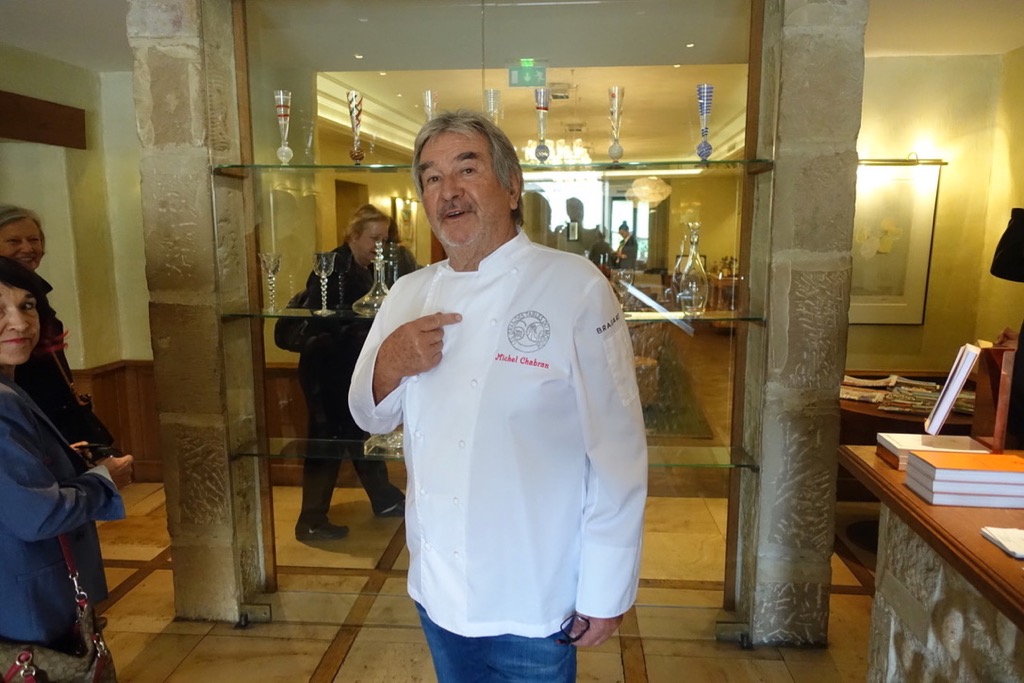
This s a truly beautiful place. when you approach the restaurant you see a façade with different ochre hues that enhance the traditional pebbles of the Rhone. You enter and you find an elegant dining room, decked out in sunshine colours, an open fireplace, a garden with many different flower and herb beds - that Michel loves to show you after a meal - ,patios and a sumptuous wine cellar. And then there is the cuisine which draws on excellent products every season that remain true to the Dauphiné and Provençal traditions. |
AFTERNOONWe leave the Northern Rhône region and drive to the Southern Rhône.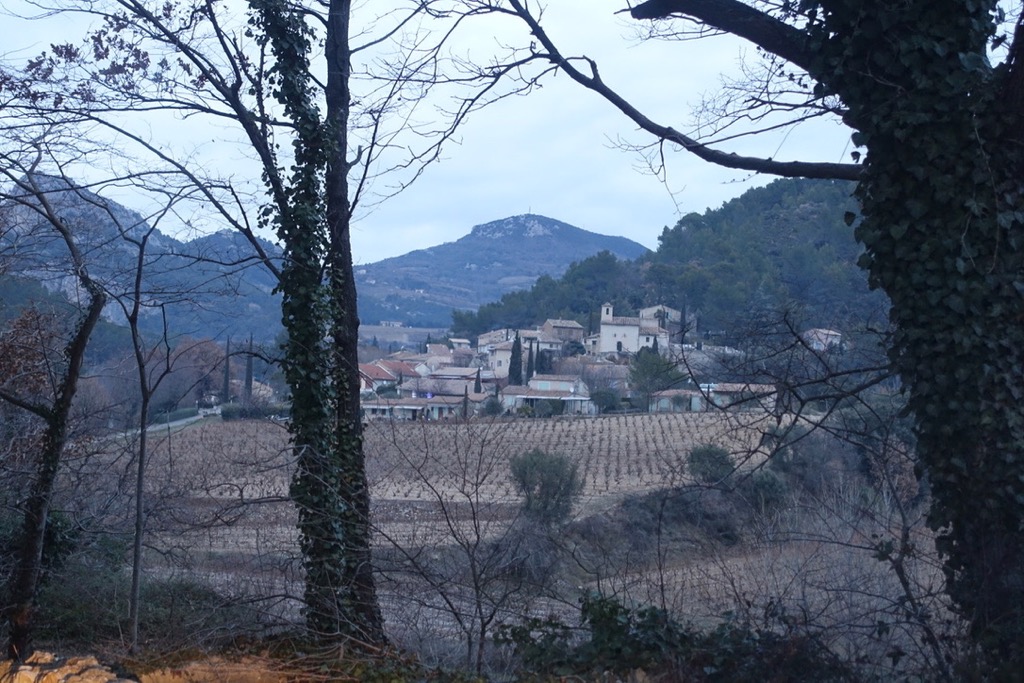
This is our longest bus ride. The closer we get to the Southern Rhône region the more beautiful the landscape gets. |
EVENINGArrival and Check in at Hôtellerie du Domaine De Cabasse in Séguret, Southern Rhône.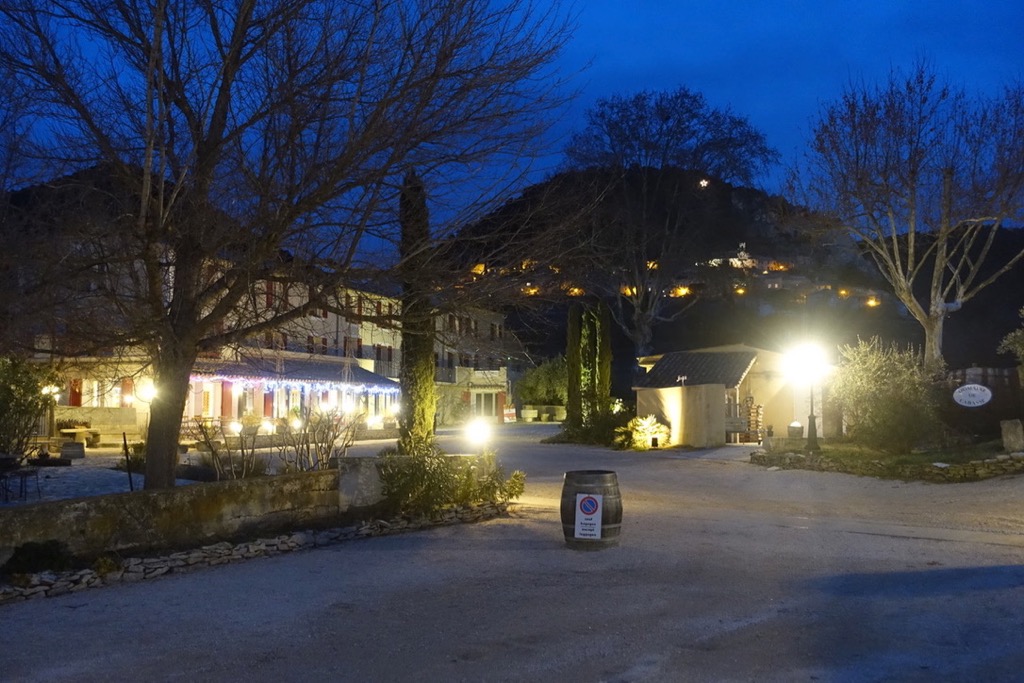
Enjoy the tranquility and the surrounding vineyards of this Provencal manor house which sits in the mids of vineyards, and soak in the stunning views towards the village of Séguret perched to the mountain in the distance. This is a true Provencal Inn with well appointed rooms, a beautiful terrace and a sizable pool. In case someone is hungry the Domaine also has a good restaurant. |
Evening and dinner on your own. |
DAY 5: Thursday, October 17 |
MORNINGLes Dentelles de Montmirail.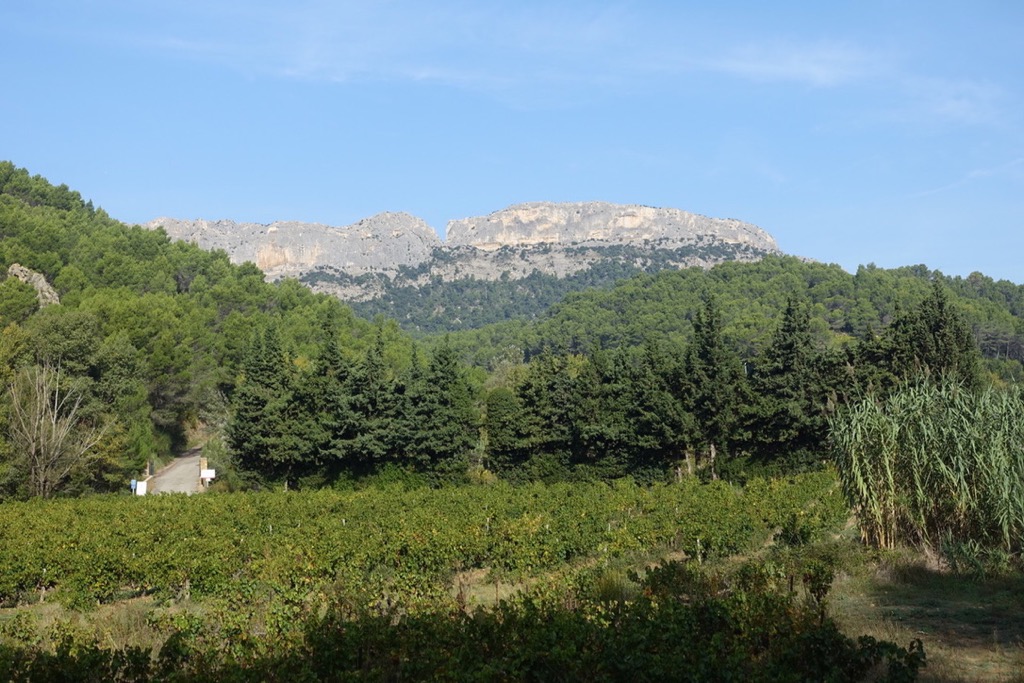
Admire the stunning Dentelles de Montmirail, a jagging mountain range visible rom afar. We drive around the Dentelles de Montmirail to the other side of the mountains. |
Cellar visit and tasting at Domaine La Martinelle in Lafare, Ventoux, Southern Rhône.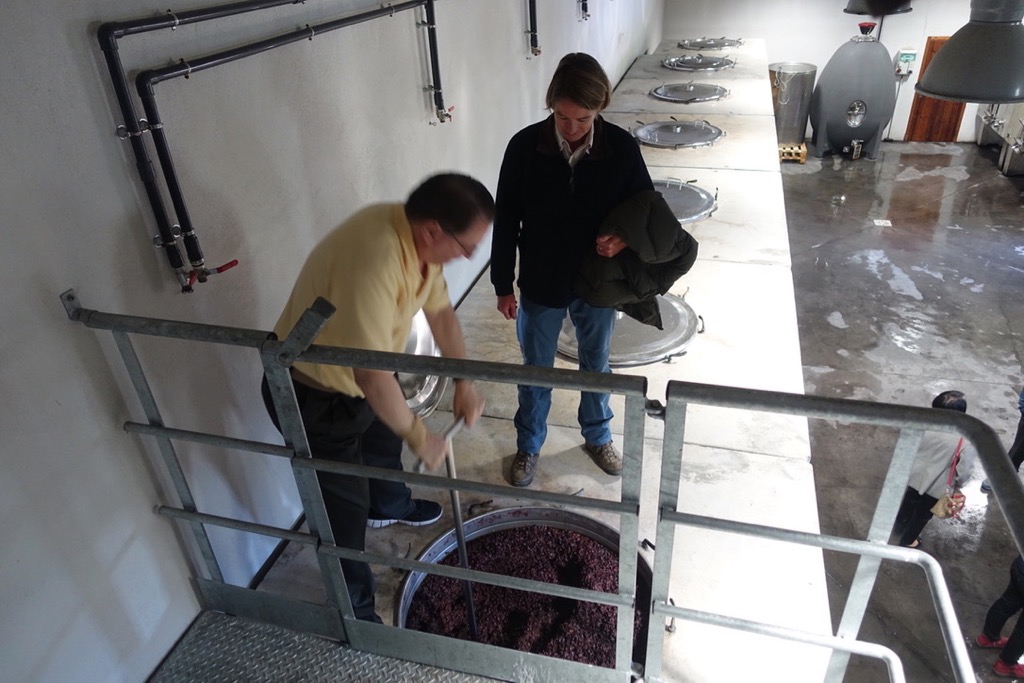
This domaine is located on the other side of the Dentelle from Gigondas and Vacqueras. was founded in 2001 by Corinne Faravel. Today the estate has 75 acres of vineyard holdings. Corinne has been making white wine in Germany’s Nahe region, but was always interested in making red wine, so she came to the Rhône Valley. Love made her stay (she is married to Thierry Faravel of Domaine La Bouissière) and in 2001 she founded Domaine La Martinelle. Ths domaine has 75 acres of vineyard holdings on a series of small, terraced hillsides that run from 810 to 900 feet in altitude. Soils are a mix of limestone (like Burgundy, thus finesse), clay (contributes body and volume) and gypsum (good for soil fertilization; probably a result of volcanic activity from the Ventoux). While much of the Ventoux is located on alluvial lowlands, this mountainous eastern corner is widely held as the highest-quality growing area of the entire appellation. The regional ‘mistral,’ or cold northern winds from the Alps, rushes through these valleys in the summer months, keeping temperatures cool. The vineyards’ altitude works to extend the growing season, with harvest often in late September through early October. |
Arrival in the village of Séguret.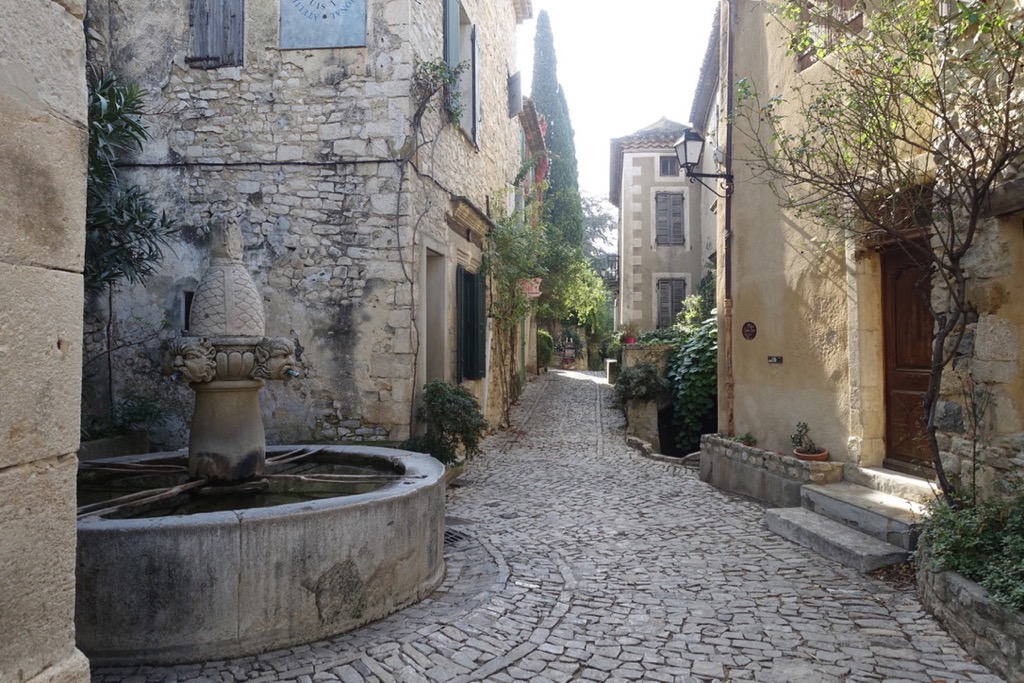
You have time to wander around on your own. To spend some time in one of the typical Provencial villages is a must, just to get a feel for the region. Séguret literally hugs the hillside topped by the ruins of its feudal château. Séguret is one of the official "most beautiful villages in France", and thoroughly deserves this distinction. You cannot withstand the charm of this medieval atmosphere, the narrow, cobblestone streets, and the historical treasures of this village. |
LUNCHLunch (beverages on your own) at restaurant Le Mesclun in Séguret.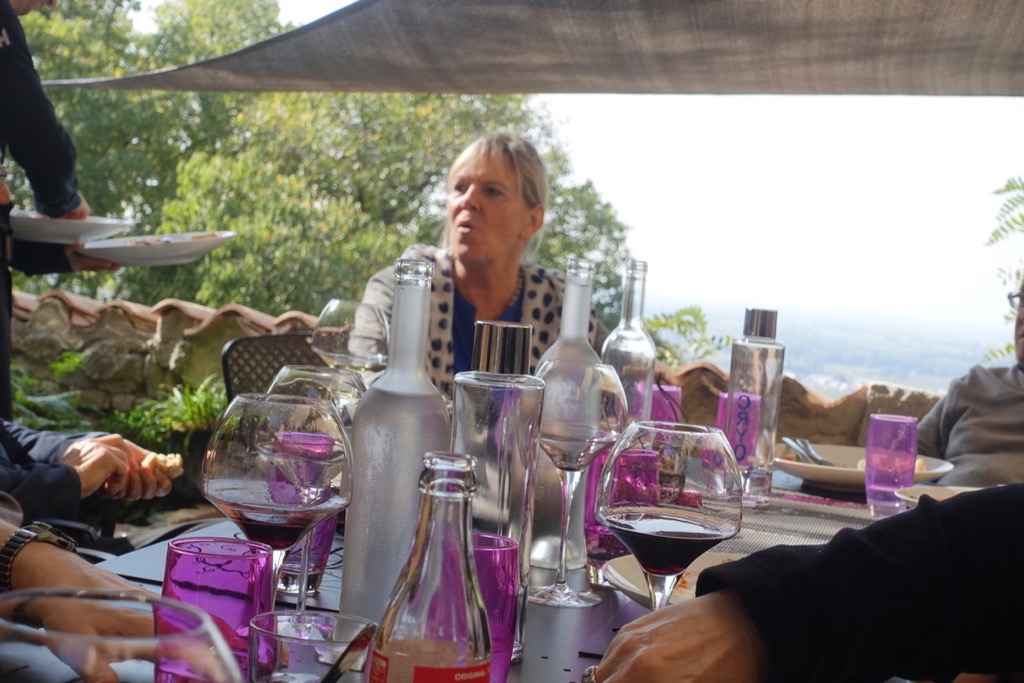
Enjoy the fantastic food and the gorgeous view from the restaurant’s terrace to the vineyard covered valley below. |
AFTERNOONWinery tour and tasting at Domaine Marcel Richaud in Cairanne, Southern Rhône.
Cairanne produces many of the best wines made in the vast Côtes-du-Rhône-Villages area. Situated atop a range of low hills, with perfect exposure, looking east over the plain between the Aigues and Ouvèze rivers, the elevation ensures slightly cooler temperatures than on the Plan de Dieu, (as the plain below is known), where the summer heat is usually extreme. Marie and Marcel Richaud run Domaine Marcel Richaud, with Marcel as winemaker and Marie as manager. They farm 130 acres. Marcel Richaud is one of the pioneers of ‘natural’ farming in the Rhône. To best describe his philosophy read his interview: “My father sold all of his grapes to a cave cooperative. The rules and politics of production meant high yields, mechanization and none of the work I do today: choosing to work with specific parcels and varietals, working organically and biodynamically, etc… So you could say that I fundamentally changed everything about the estate. We work organically so no chemicals, herbicides or pesticides. We work the soils. For me the vines are an entity that you cultivate, that you guide like you would a friend or fellow human being. Some people treat and heal others. My job is to treat and heal the earth and the vines. You need to take care of both because healthy soils lead to healthy vines. The cellar is the accumulation and the payoff of what we've been doing all year in the vines. My grandfather used to say something that I find very simple and beautiful: "The Earth only gives you what you make." He was right. You can't treat the earth like an entrepreneur. You have to work with it, to learn to love it.” |
Tasting at Domaine de Cabasse, Séguret, Southern Rhône.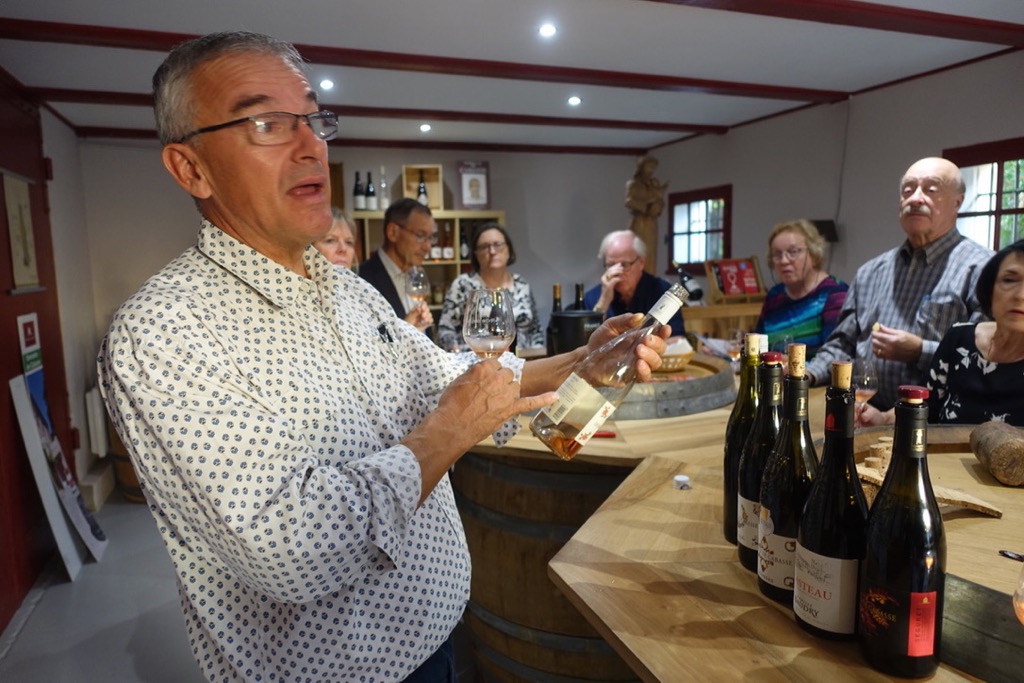
We will have a thorough tasting at our domicile for two nights, Domaine de Cabasse with our host Benoit Baudry. Domaine de Cabasse was founded in the 1950s. In 1991 a Swiss couple bought the domaine, then in 2012 Anne and Benoit Baudry from the Loire valley acquired the estate and opened the hotel. The 30 acres of vineyards are located around the domaine with 12 acres in the Côtes du Rhône Villages Sablet, 17.5 acres in the Côtes du Rhône Villages Séguret, and 7.5 acres in the Cru Gigondas appellation. The vines grow on an exceptional terroir. Located at the foot of the Dentelles de Montmirail, the soils derived from calcareous rocks decomposed with varying proportions of pebbles giving the grapevine only what it needs for perfect growth. The south-west facing slopes guarantee optimal sun exposure and ripeness. |
EVENINGDinner with wine pairing at restaurant L'Oustalet (* Guide Michelin) in Gigondas.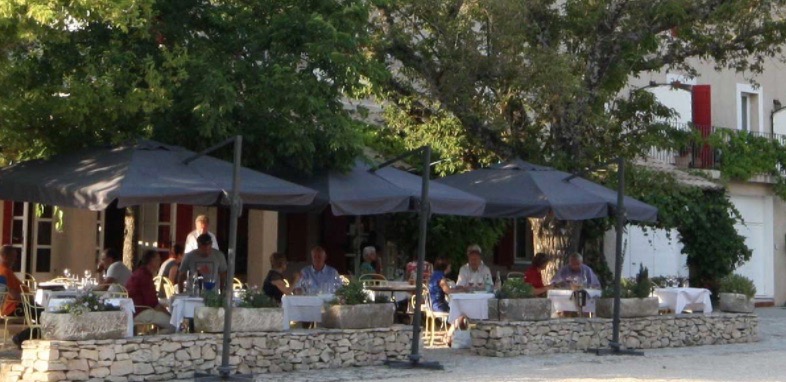
We will enjoy a relaxed evening sharing a three course menu carefully prepared by the resident chef with matching wines choosen by Benoit Baudry. |
DAY 6: Friday, October 18 |
MORNINGCellar visit and tasting at Domaine La Bouïssière, Gigondas, Southern Rhône.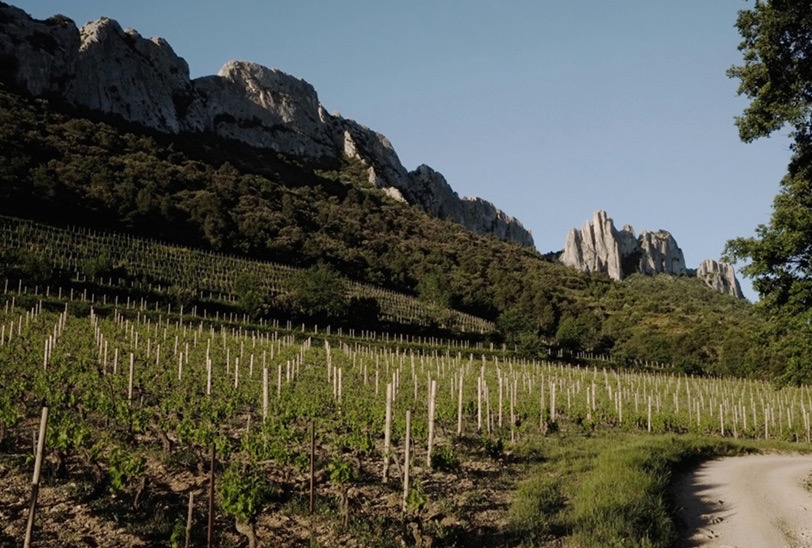
In the opinion of Robert Parker and other experts, Gilles and Thierry Faravel of La Bouïssière along with Santa Duc and Château Saint Cosme are the superstars of the Appellation and perhaps the whizzards of the Rhône at all. The 45 acres of vineyards of this estate are located on some of the highest vineyards in Gigondas. Thierry and Giles’ father Antonin Faravel carved the vineyards out of the stone cliffs of the Dentelles de Montmirail (see picture) in the 60s. He was aware of the hot southern climate and knew that the cooler temperatures of the higher altitude and the rocky soils would produce perfectly ripe grapes that would produce wines with more acidity and a moderate alcohol level. Vineyard work is done according to organic principles. The oldest vines are between 60 and 70 years old. Harvest is performed by hand, and grapes are partially destemmed and lightly crushed, depending on the vintage. Fermentation on indigenous yeasts takes place in unlined cement tanks or stainless steel tanks; wines age in a combination of tank, larger foudre and barrique. Wines are bottled by gravity and are unfined and unfiltered. I quote North Berkely Imports: “Yet it certainly takes more than a mountain to make a world-class red. Winemakers Thierry and Giles Faravel, border on the fanatical when it comes to the health of their vines and grapes. Theirs are wines that are intimately tied to and faithfully reflect the rugged, sensual beauty of the Provençal landscape from which they’re born.” |
Visite of the Abbaye Notre Dame de Sénanque in Gordes.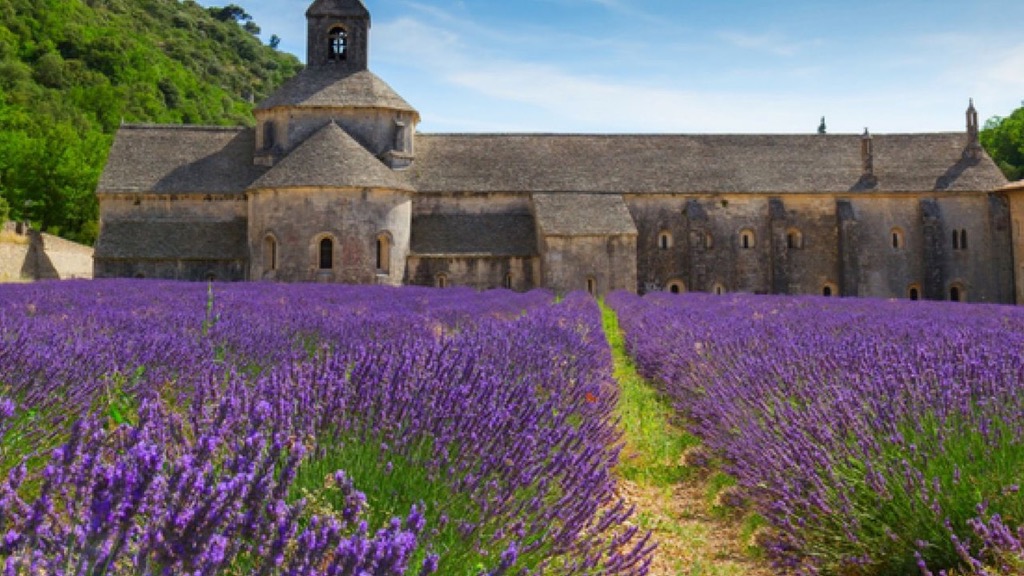
The Abbaye Notre-Dame de Sénanque was founded in July 1148 by Cistercian monks. The abbey belongs to a powerful monastic order, carried by the aura of Saint Bernard. The community lives from the work of the Brothers: lavander culture, olive groves, apiary, visits to the Abbey, hotel and monastic shop to meet the needs of the community, but especially to cope with financing the maintenance and restoration of the Sénanque Abbey. The Abbey is surrounded by lavender fields and the view over the puple fields during the flowering season towards the Abbey is just incredibly beautiful.
|
LUNCHLunch (beverages on your own) at restaurant La Trinquette.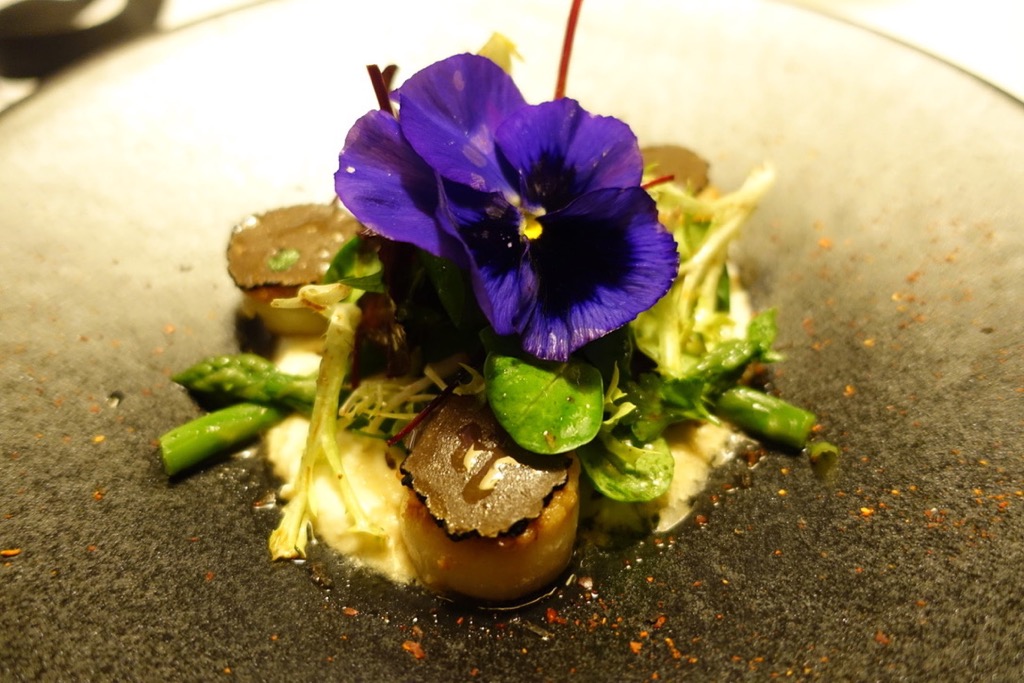
From the La Trinquette restaurant you have the best view in Provence. The balcony looks out in a grand sweep from the vertiginous heights of Gordes across the Luberon. The food is carefully prepared and absolutely delicious. |
AFTERNOONWinery tour, and tasting of wine and olive oil at Mas Saint Berthe, Les Baux de Provence.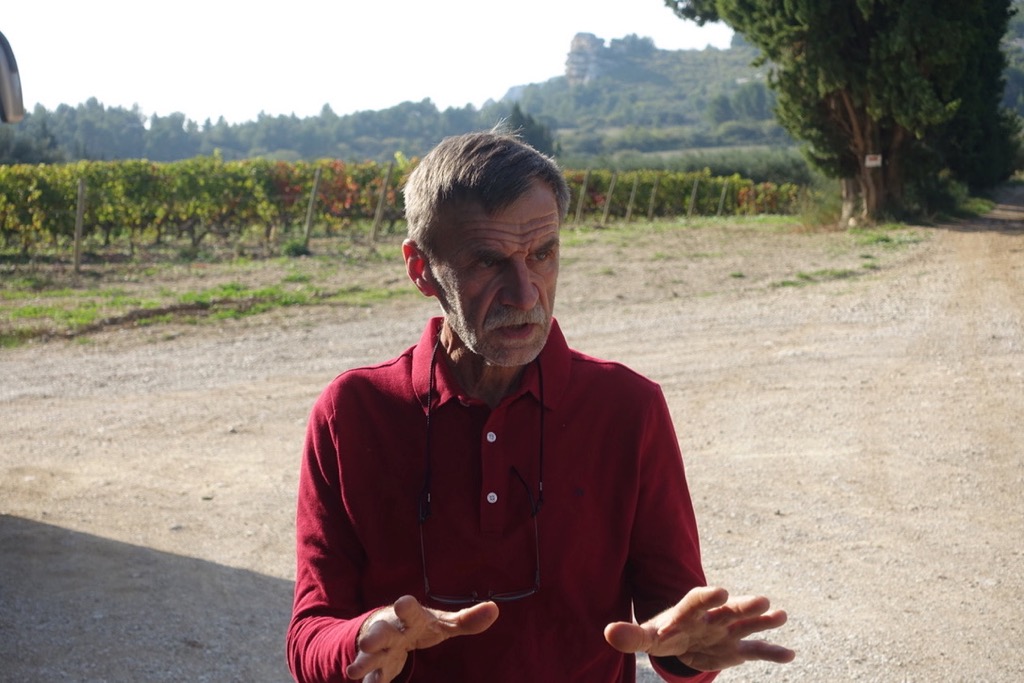
As early as the 17th centuries farms dotted the country side here. In 1950 the David family acquired the fruit farm Mas Saint Berthe. (“Mas” is the provençal word for “Domaine”). The Davids had a passion for wine and decided to gradually replace apricot tress with vines. In 1976 the construction of the cellars was terminated and they produced their first wine. Today Mas Saint Berthe has 100 acres of vineyards at the foot of the Baux rock formation which is part of the Alpilles mountain range in the heart of the Baux AOP. The red grape varieties are: Grenache, Syrah, Cabernet Sauvignon, Mourvèdre, Cinsault, Carignan. There are five white grape varieties: Grenache blanc, Rolle, Sauvignon, Ugni blanc, Roussane. The portfolio comprises wines of the AOP Les Baux de Provence appellation and two I.G.P. Alpilles. There also is an olive grove of 6 acres with 4 local varieties: Grossane, Salonenque, Verdale for the production of Baux valley olive oil and Tapenade and Green Picholine olives. |
EVENINGArrival and check in at Hôtel Le Mas d'Oulivié in Les Beaux, Provence.Enjoy the beautiful, elegant setting, relax in the gorgeous garden, take a dip in the pool, and get a feel for a provençal lifstyle. |
DINNER(beverages on your own) at restaurant Le Mas d'Oulivié.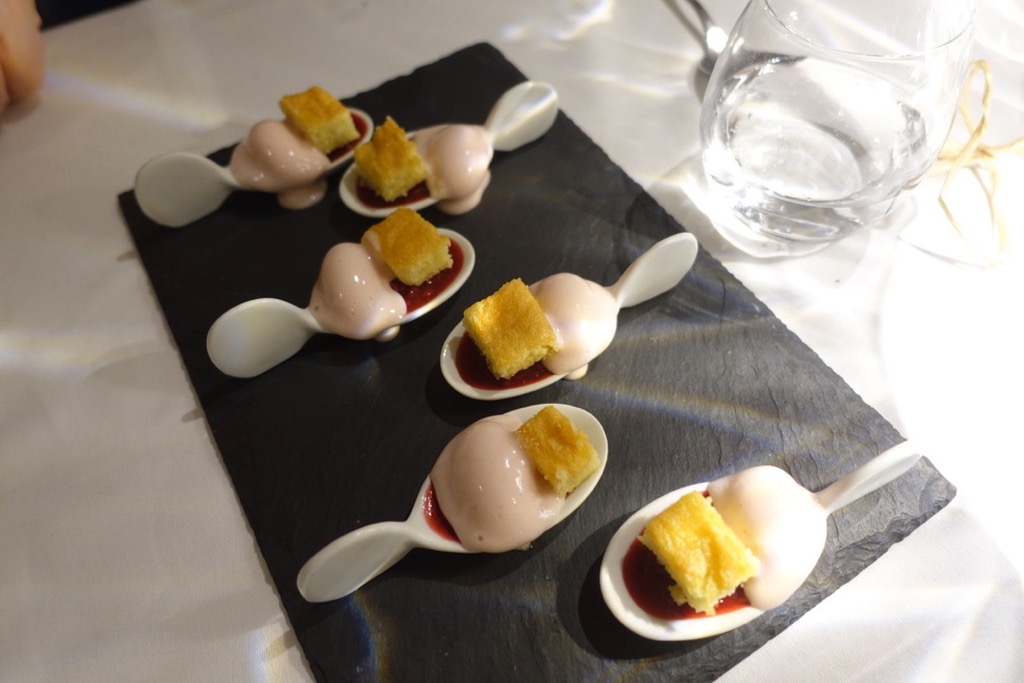
We will have an evening cocktail in the superb park with bites prepared by chef Thomas Voisin. |
DAY 7: Saturday, October 19 |
Today is our day of the three "Must See" cultural sights in the Southern Rhône area. |
MORNINGWalking tour through Arles. An English speaking expert will give us a tour and will explain the Roman history of Arles.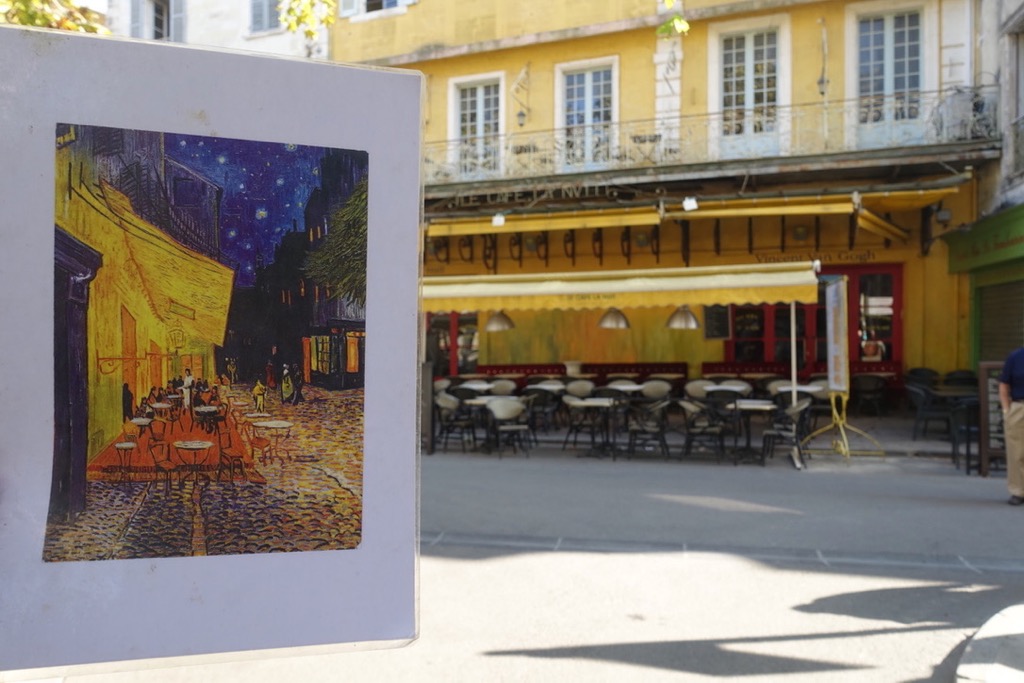
When visiting the Southern Rhône a visit to Arles is a “must”. Arles exists since the 800 BC but it became an important city much later when it came under Roman influence in 123 BC. During the Late Roman Empire Arles was the cultural and religious center and the city reached its peak of influence during the 4th and 5th centuries, when Roman Emperors frequently used it as their headquarters during military campaigns. Arles is also knows as the city of Van Gogh. It was here where he produced some of his most famous paintings. |
LUNCHLunch menu (beverages on your own) at restaurant Les Terrasses at Pont du Gard.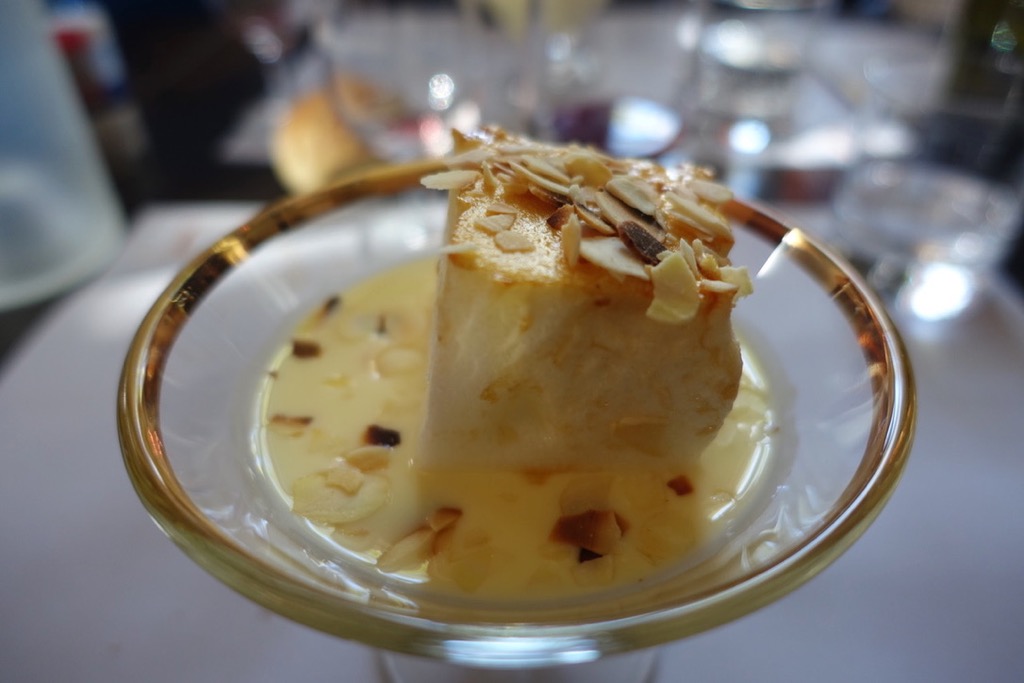
A Hopefully the weather cooperates and we can sit on the terrace with a beautiful view of the Pont du Gard. |
AFTERNOONTouring the Pont du Gard.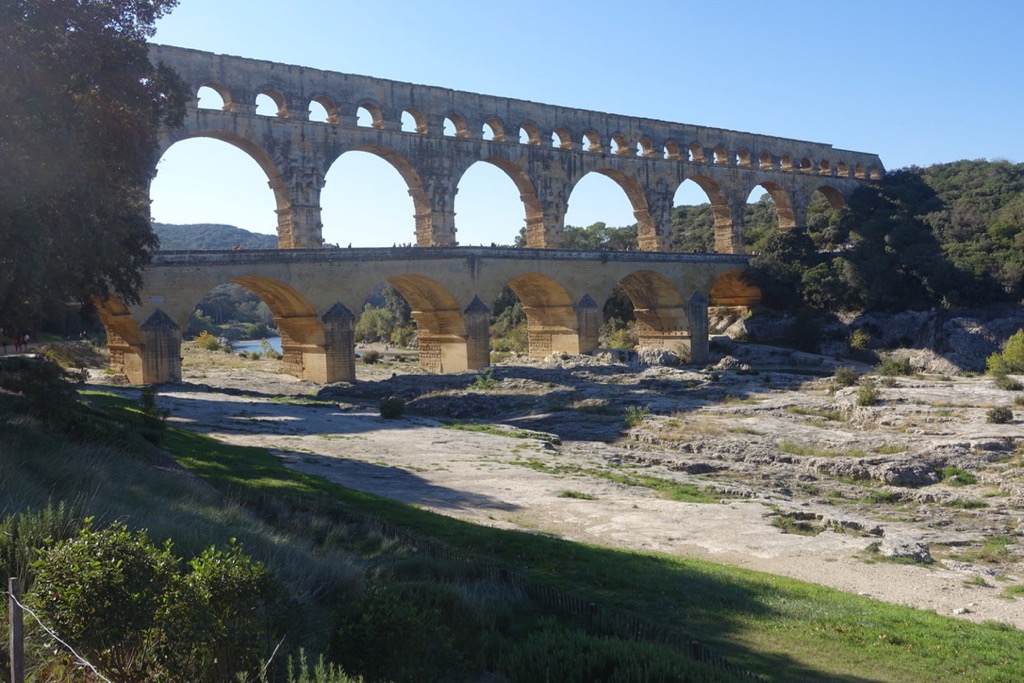
A visit to the Pont du Gard is the second “must” in the Southern Rhône region. The Pont du Gard is a Roman aqueduct bridge built in the first century AD that was part of a sophisticated system bringing water to the Roman colony of Nîmes. It is a UNESCO World Heritage Site and truly fascinating. |
Guided tour of the Palace of the Popes in Avignon.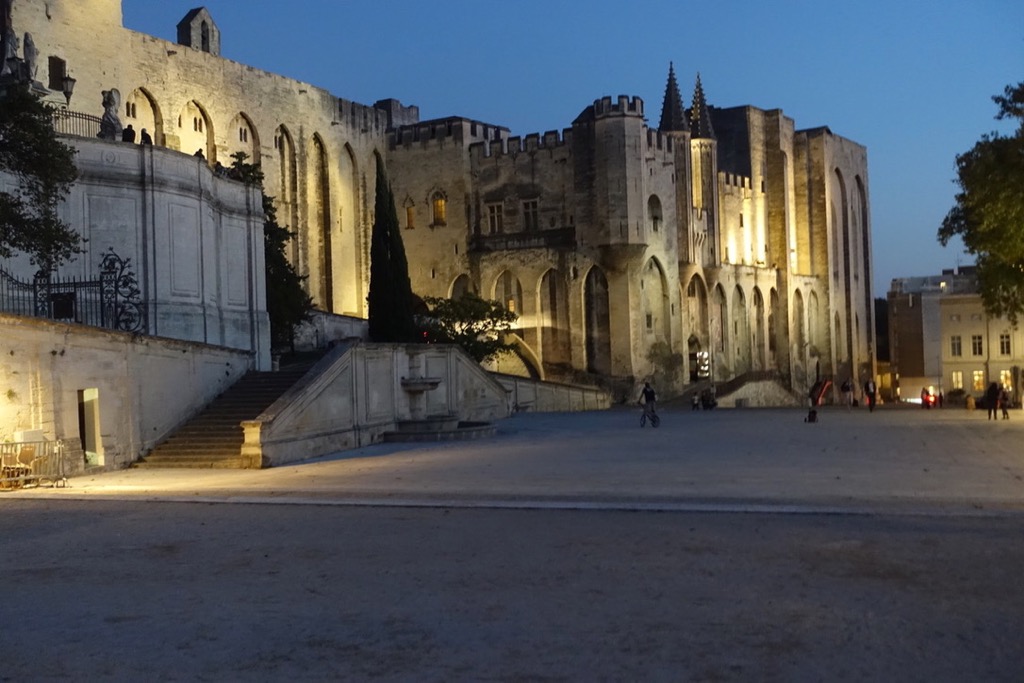
To pay a visit to the Palace of the Popes is the third “must” when travelling in the Southern Rhône region. The palace is one of the largest and most important medieval Gothic buildings in Europe. It is also of great importance for European and Christian history given the fact that between 1309 and 1377 the Roman Catholic Papacy resided in Avignon and the Popes took residence in the ‘Palace of the Popes’. |
EVENINGBack at Hotel le Mas d'Oulivié.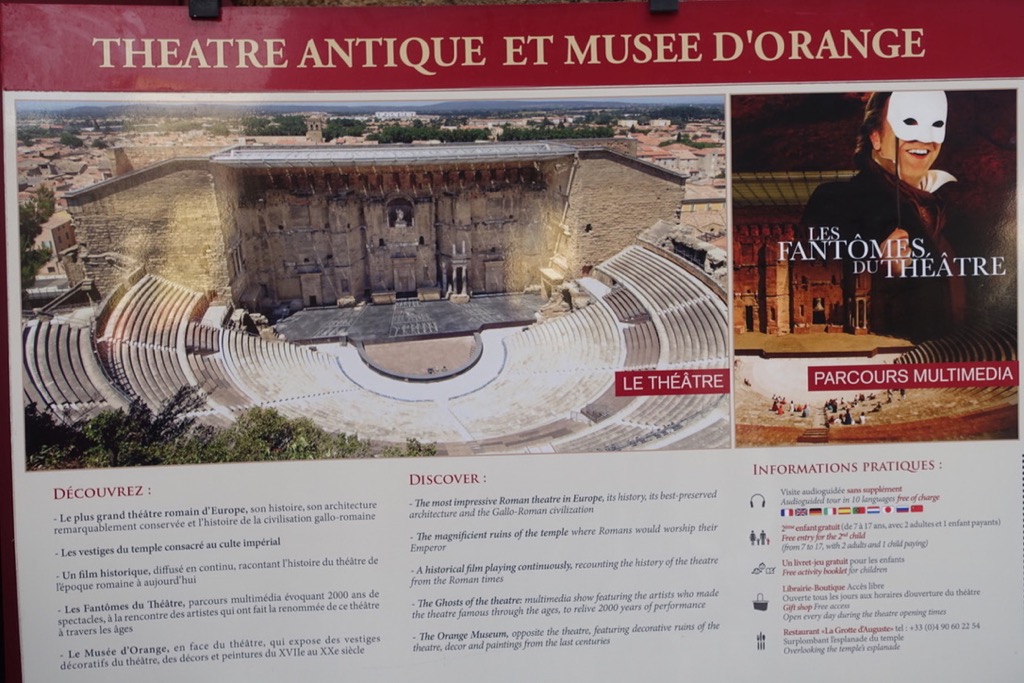
The hotel sits in a quiet, beautiful park. Take advantage of the pool and the quiet ambiance. |
DAY 8: Sunday, October 20 |
MORNING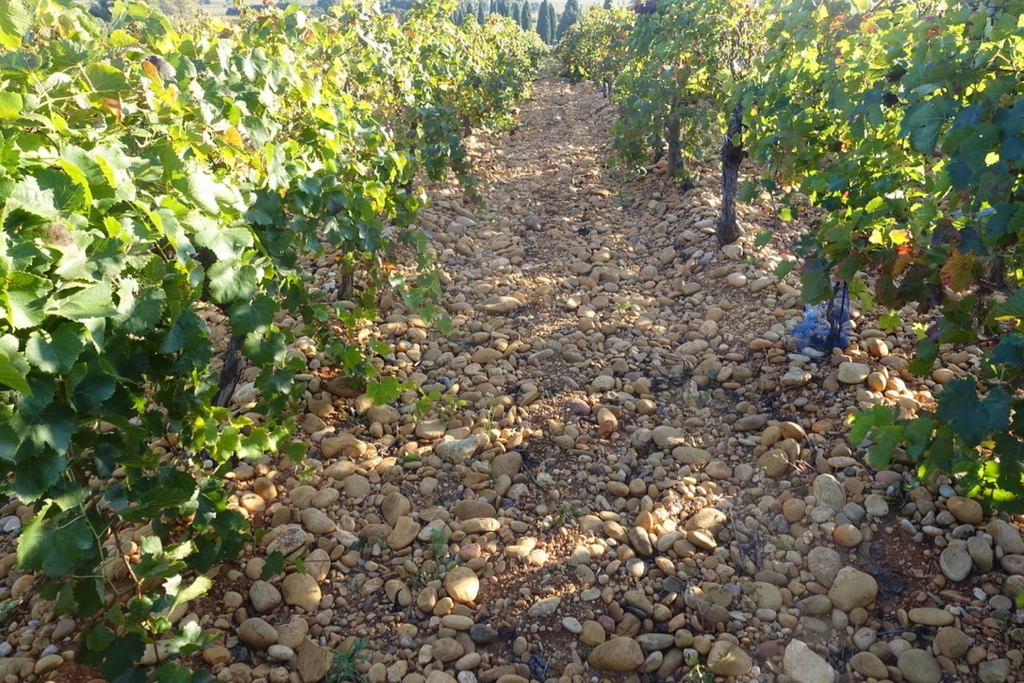
This is our first day in the world-famous Châteauneuf-du-Pape wine region. “Popes throughout history have liked their juice, and when the papal see moved to Avignon in the 13th century, that juice was Châteauneuf-du-Pape ("the pope's new castle") made from grapes grown nearby in the Southern Rhône. The castle is a ruin now, the papal court long gone back to Rome, but the wines that bear the pope's coat of arms emblazoned on the bottle are still produced more or less according to the long-standing recipe. Not every winemaker uses all 13 of the grapes in the prescribed blend, though.” (excerpt from an article in the Los Angeles Times). The vines grow on a soil that is a mixture of large quartz stones (galets roules) and sandy red clay. The galets roules reflect the sunlight and have a warming effect. A very strong southern wind - the Mistral - whips up through the Rhône valley from the Mediterranean Sea and creates a welcome cooling effect since the region can be pretty hot and dry. With more than 8,000 acres under vine, Châteauneuf-du-Pape is the largest appellation in the Rhône. Châteauneuf-du-Pape was the first vineyard in France, in 1924, to have all of its wine protected as an established name. This was the forerunner of the AOC – now AOP classification. |
Cellar tour and tasting at Château de Beaucastel in Courthézon, Châteauneuf du Pape.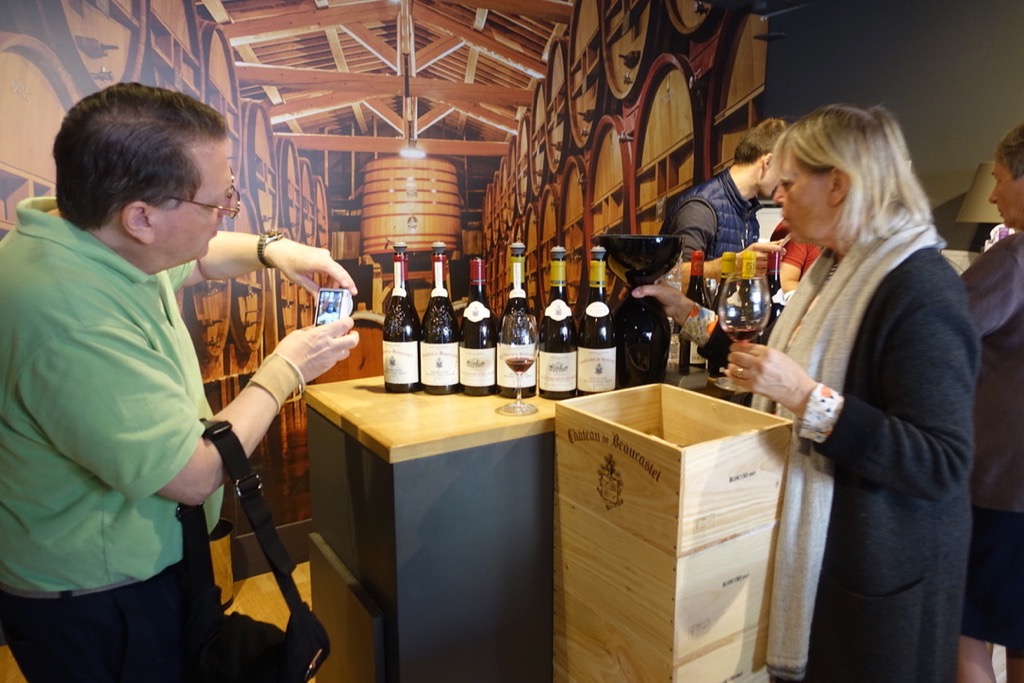
This is our first visit of a wine domaine in the famous Châteauneuf-du-Pape wine region. “Popes throughout history have liked their juice, and when the papal see moved to Avignon in the 13th century, that juice was Châteauneuf-du-Pape ("the pope's new castle") made from grapes grown nearby in the Southern Rhône. The castle is a ruin now, the papal court long gone back to Rome, but the wines that bear the pope's coat of arms emblazoned on the bottle are still produced more or less according to the long-standing recipe. Not every winemaker uses all 13 of the grapes in the proscribed blend, though.” (excerpt from an article in the Los Angeles Times). Some of the truly great Châteauneuf-du-Pape wines are produced at Château de Beaucastel. Château de Beaucastel was first mentioned in 1549 and came into the possession of the Perrin family in 1909 when scientist Pierre Perrin inherited the Château de Beaucastel estate. Perrin's grandchildren, François and Jean-Pierre, founded the Famille Perrin business together before passing on the reins two years later to the fifth-generation Pierre Perrin in 1999. In addition to its renowned Château de Beaucastel estate, Famille Perrin's portfolio includes Miraval, Domaine du Clos des Tourelles and La Vielle Ferme, established as a brand in the 1970s. Today the Perrin family is the largest vineyard owner of the Southern Rhône and has properties in the best terroirs of the valley including the famous lieu dit ‘La Crau’. They were pioneers in organic farming when they implemented these ideas in 1953 and they started biodynamic vineyard management in 1970. They also were the first to believe in the potential of growing Southern Rhône grape varietals in Paso Robles in the US. They teamed up with Robert Haas of Vineyard Brands who was their US importer. Together they established the Tablas Creek winery in Paso Robles, California. |
Visit and tasting at Vignobles Alain Jaume, Domaine Grand Veneur in Courthézon, Châteauneuf du Pape.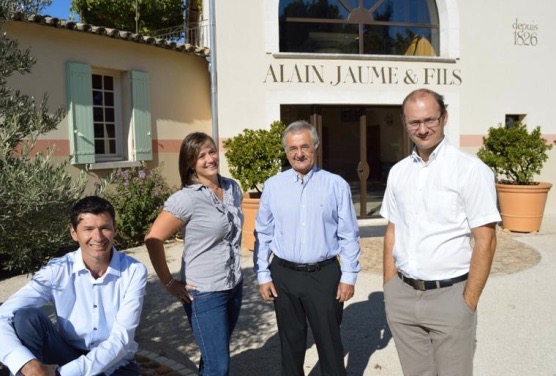
The Jaume family first planted vines in 1826. Five generations later, in 1979, Alain Jaume took over and in 1996 he created Domaine Grand Veneur to bottle and age the wines under their own label. Today his two sons, Sébastien and Christophe, and his daughter Hélène (see picture to the left) also work at the estate, hence the 6th generation is maintaining the traditions that made the estate one of the greatest in Châteauneuf-du-Pape. The family produces estate wines and négociant wines. The estate wines comprise 225 acres: “Domaine Grand Veneur” (15 acres Châteauneuf-du-Pape), “Château Mazane” (35 acres in Vacqueyras), “Clos de Sixte” (80 acres in Lirac), and “Domaine de la Grangette Saint Joseph (95 in the Vaucluse, Côte de Rhône appellation. These estate wines are farmed in certified organic agricultural practices. The négociant wines are labeled “Alain Jaume” and are from purchased grapes and wines from winegrowing partners in several Southern Rhône appellations. The estate wines of the Jaume family are regarded as belonging to the upper echelon of Southern Rhône wines. The same attention to detail is paid to the winemaking of the négociant wines. The négociant wines are simply great wines at great prices with strength, complexity, and finesse. |
LUNCHWine pairing lunch at La Table d’Alain Jaume at Domaine Grand Veneur.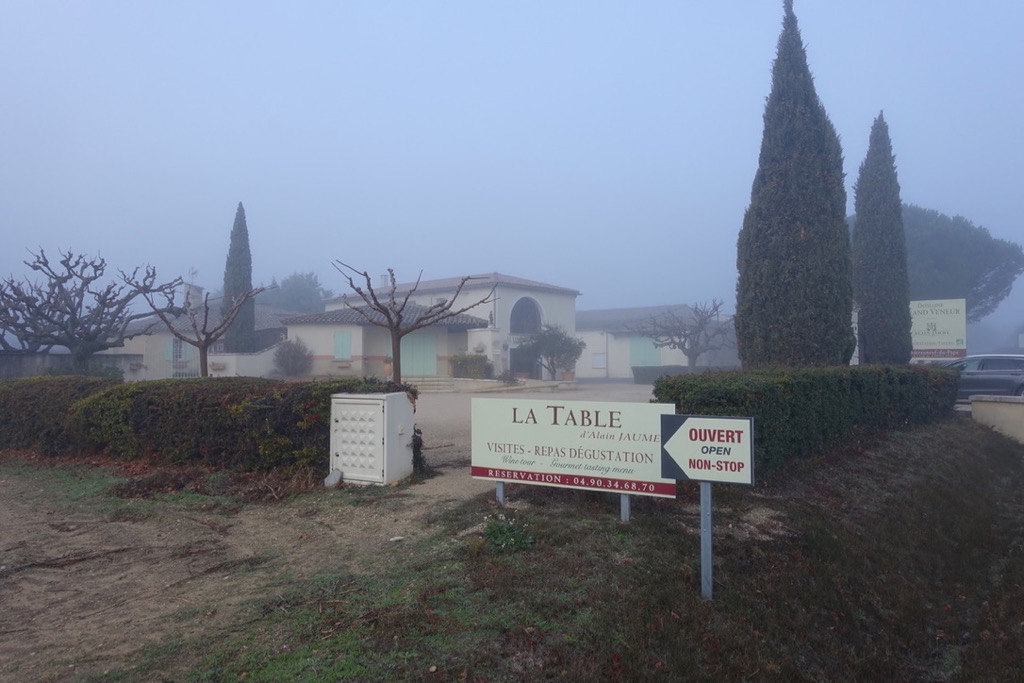
We will compare how wines taste differently before a meal and with food. A delicious meal with matching wines from all Jaume appellations will be served. Hopefully we can sit on the terrace with panoramic views of Châteauneuf-du-Pape. |
Guided tour of Pont Saint-Bénézet in Avignon.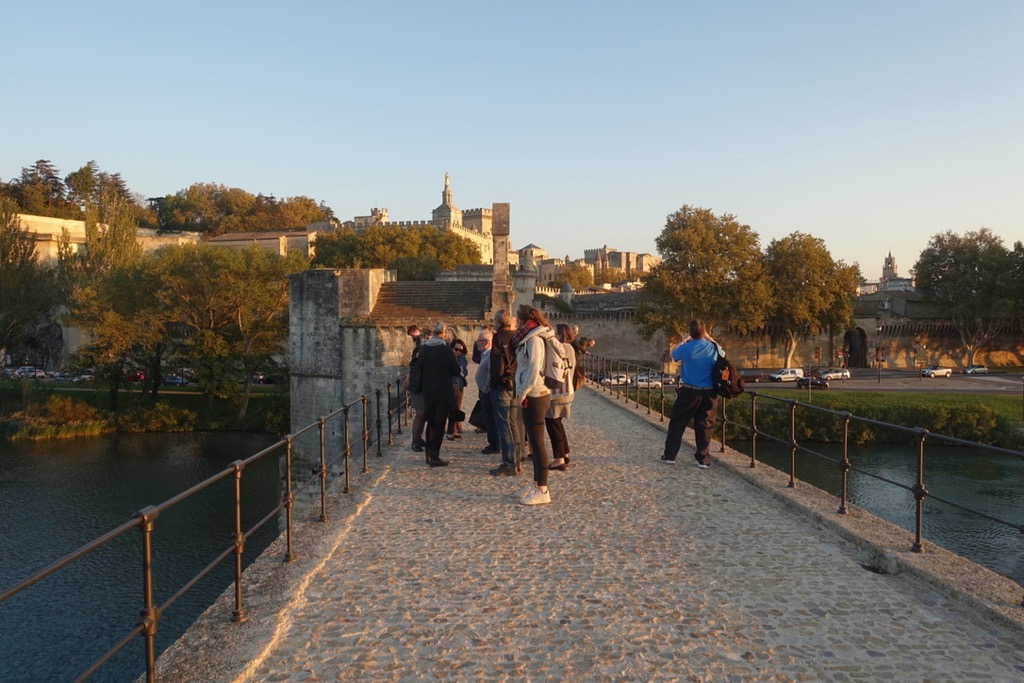
This is the famous ruin of the so-called ‘Pont d’Avignon’, a wooden bridge across the Rhône river built between 1177 and 1185. It is beautiful to stand at the end of the half bridge in the middle of the Rhône river with a beautiful view towards the ancient city walls of Avignon and the turrets of the Palace of the Popes. |
EVENINGCheck-in at Hotel Mercure in Avignon.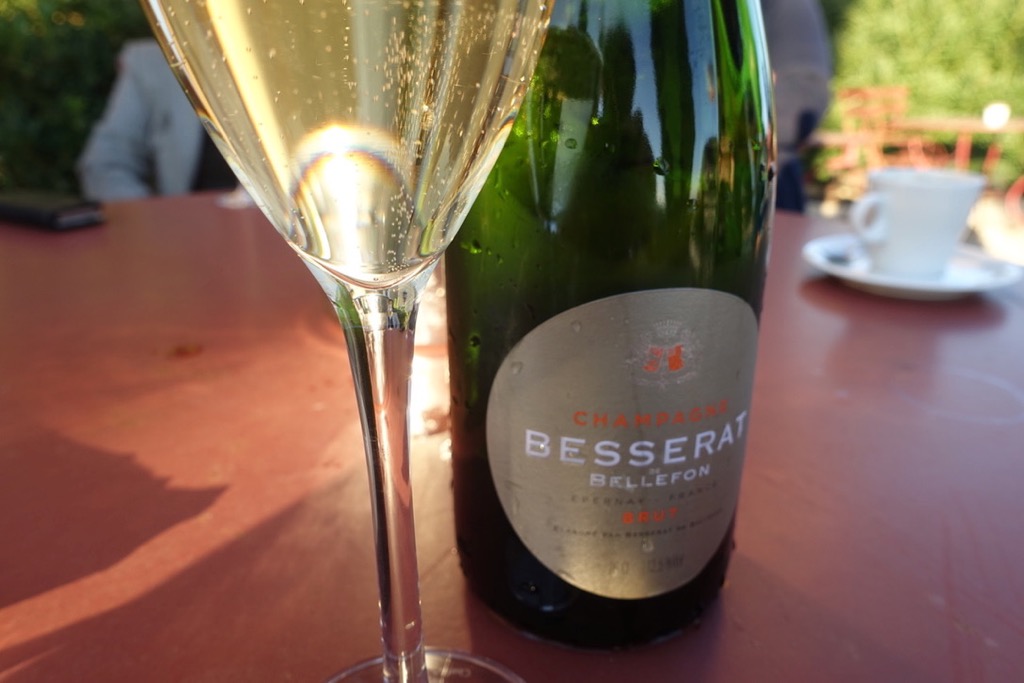
Evening on your own in this beautiful city of Avignon. The hotel is less than 5 minutes from the Papal Place and the main square of the city with restaurants, and wine bars. |
DAY 09: Monday, October 21 |
MORNINGCellar tour and tasting at Château de Beaucastel in Courthézon, Châteauneuf du Pape.
This is our first visit of a wine domaine in the famous Châteauneuf-du-Pape wine region. “Popes throughout history have liked their juice, and when the papal see moved to Avignon in the 13th century, that juice was Châteauneuf-du-Pape ("the pope's new castle") made from grapes grown nearby in the Southern Rhône. The castle is a ruin now, the papal court long gone back to Rome, but the wines that bear the pope's coat of arms emblazoned on the bottle are still produced more or less according to the long-standing recipe. Not every winemaker uses all 13 of the grapes in the proscribed blend, though.” (excerpt from an article in the Los Angeles Times). Some of the truly great Châteauneuf-du-Pape wines are produced at Château de Beaucastel. Château de Beaucastel was first mentioned in 1549 and came into the possession of the Perrin family in 1909 when scientist Pierre Perrin inherited the Château de Beaucastel estate. Perrin's grandchildren, François and Jean-Pierre, founded the Famille Perrin business together before passing on the reins two years later to the fifth-generation Pierre Perrin in 1999. In addition to its renowned Château de Beaucastel estate, Famille Perrin's portfolio includes Miraval, Domaine du Clos des Tourelles and La Vielle Ferme, established as a brand in the 1970s. Today the Perrin family is the largest vineyard owner of the Southern Rhône and has properties in the best terroirs of the valley including the famous lieu dit ‘La Crau’. They were pioneers in organic farming when they implemented these ideas in 1953 and they started biodynamic vineyard management in 1970. They also were the first to believe in the potential of growing Southern Rhône grape varietals in Paso Robles in the US. They teamed up with Robert Haas of Vineyard Brands who was their US importer. Together they established the Tablas Creek winery in Paso Robles, California. |
DAY 10: Monday, October 21 |
MORNINGWinery visit and tasting at Domaine de La Solitude in Châteauneuf du Pape.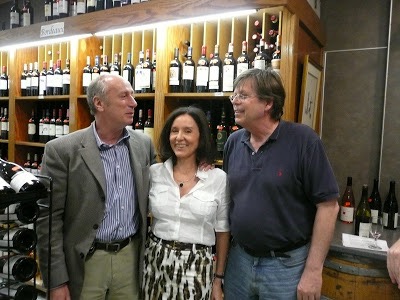
Domaine de La Solitude belongs to one of the most ancient families native of Chateauneuf du Pape. This classic Domaine, owned by the Lançon family, dates back to 1535. The first member of the family came from Italy in 1264 to serve the Pope in Avignon. His name was Barberini - the name today of the special cuvées. Over the centuries, the Lançons had two Bishops and even one Pope in their family. The three hats on the label refer to this. The medal on the label refers to a medal that one family member received from Napoleon after the battle of Waterloo. The three bees on the label is a family weapon from the Middle Ages. Today the brothers Jean (see picture: Jean and his wife Françoise) and Michel Lançon are in charge of the Domain, together with Florent Lancon, the son of Michel. It is a large, 92 acres property. The regular cuvée of the Domaine de La Solitude is a very traditional Châteauneuf-du-Pape. The Barberini and Réserve Secrète are more modern-style Châteauneuf-du-Pape wines. 20 acres are planted with white varieties: 30% Roussanne, 50% Grenache Blanc, 15% Clairette and 5% Bourboulenc. 75 acres are planeted with red varities: 60% Grenache, 15% Syrah, 10% Mourvedre, 5% Cinsault and 10% other. |
MORNINGWinery visit and tasting at Domaine de La Solitude in Châteauneuf du Pape.
Domaine de La Solitude belongs to one of the most ancient families native of Chateauneuf du Pape. This classic Domaine, owned by the Lançon family, dates back to 1535. The first member of the family came from Italy in 1264 to serve the Pope in Avignon. His name was Barberini - the name today of the special cuvées. Over the centuries, the Lançons had two Bishops and even one Pope in their family. The three hats on the label refer to this. The medal on the label refers to a medal that one family member received from Napoleon after the battle of Waterloo. The three bees on the label is a family weapon from the Middle Ages. Today the brothers Jean (see picture: Jean and his wife Françoise) and Michel Lançon are in charge of the Domain, together with Florent Lancon, the son of Michel. It is a large, 92 acres property. The regular cuvée of the Domaine de La Solitude is a very traditional Châteauneuf-du-Pape. The Barberini and Réserve Secrète are more modern-style Châteauneuf-du-Pape wines. 20 acres are planted with white varieties: 30% Roussanne, 50% Grenache Blanc, 15% Clairette and 5% Bourboulenc. 75 acres are planeted with red varities: 60% Grenache, 15% Syrah, 10% Mourvedre, 5% Cinsault and 10% other. |
Cellar tour and tasting at Domaine du Pegau in Châteauneuf du Pape.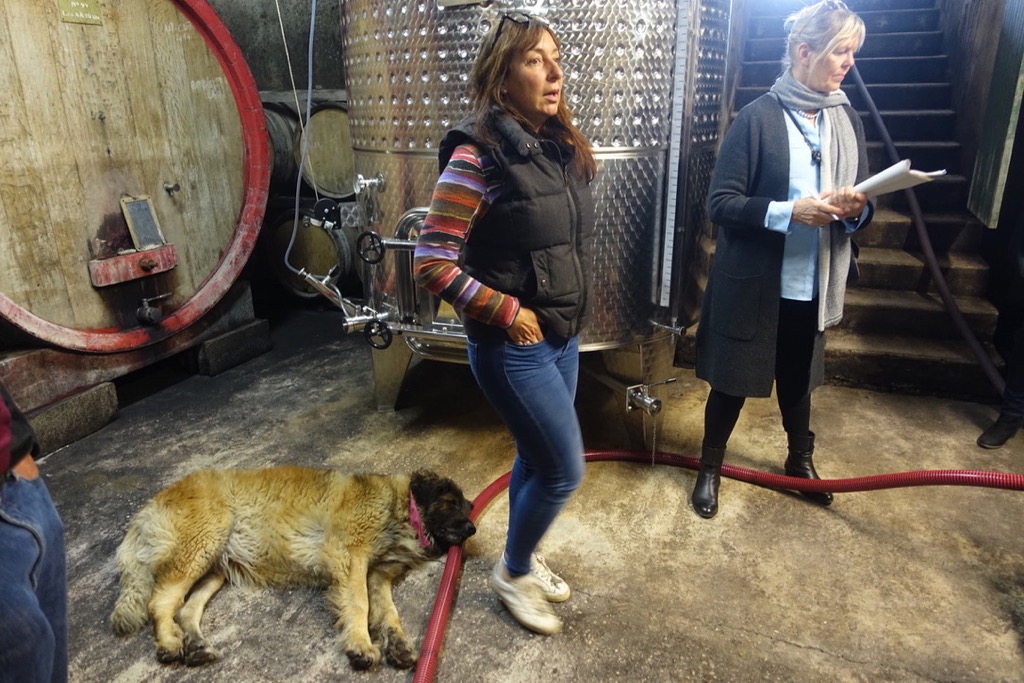
There is evidence that the Féraud family cultivated vines as early as 1733. However Domaine Pegau only came into existence in 1987 when Paul Féraud and his daughter Laurence created the estate with initially 17,5 acres of vineyard holdings. Today the domaine has a total of 51 acres in the Châteauneuf du Pape appellation with a small percentage (about 4 acres) of white grapes; 67 acres of the Côte du Rhône Village appellation, 5 acres of Côte de Rhône, and 53 acres VSIG (vins sans identité géographique – vin de France). Pegau produces two special Châteauneuf du Pape red cuvées: one is the ‘Cuvée da Capo’ made most years and coming from a plot in La Crau. The lieu dit ‘La Crau’ is a very special plot in the Châteauneuf du Pape vineyard sites and the most famous one. It is the area towards Courthézon and particularily rich in the galets roulés, round rocks or pebbles covering the clay soil, and perfect for retaining the heat. Domaine Pegau is one of the top Châteauneuf du Pape producers and always among the top 3 in France’s Revue du Vin, Wine Advocate and other important magazines.
|
LUNCHLunch on your own in the village of Châteauneuf du Pape.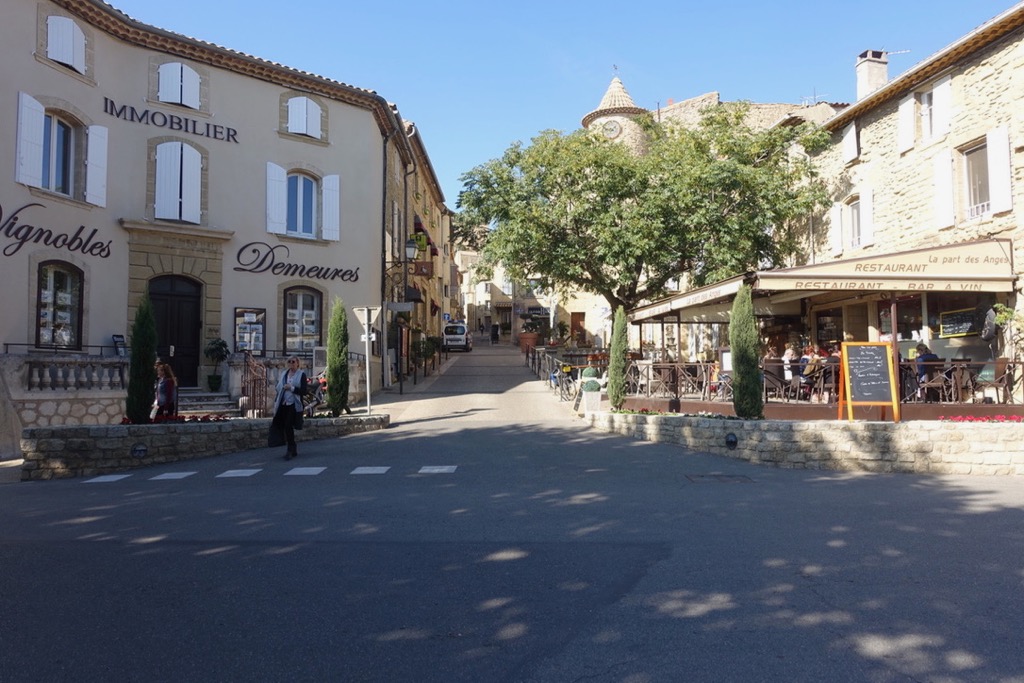
Check out the small but famous village of Châteaunauf du Pape. There are many wine shops ‘caveau’ where you can taste wines – also right in the center of town you find the caveau of the Perrin family, owners of Château de Beaucastel. Lunch is on your own. |
AFTERNOONVisit of the ruins of the Summer Palace of the Popes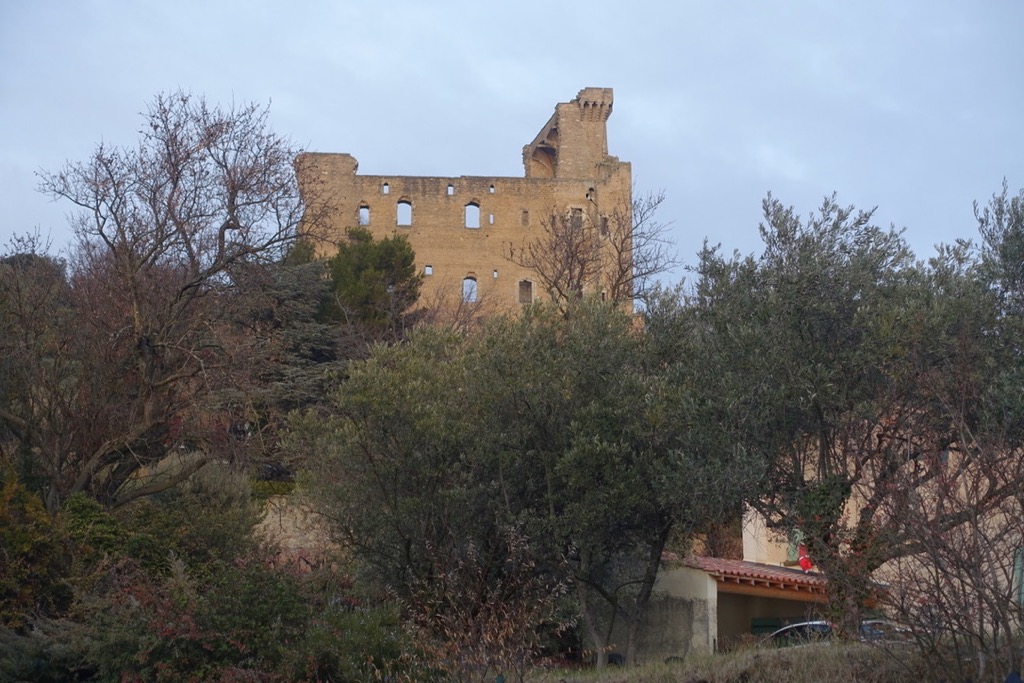
We drive up to the Pope’s summer palace that gave the village and vineyard appellation its name. Today we can only see the ruins of the medieval castle which sits at the top of the village and dominates the landscape to the south. It was built in 1320. The Popes of Avignon built their summer palace here to get away from busy Avignon. Only two walls and the foundation remain of the château. The walls are facing the village, and you see them from afar. They are still high and imposing, giving a good impression how it must have looked like centuries ago. |
AFTERNOONCheck in at Hôstellerie du Château des Fines Roches in Châteauneuf du Pape.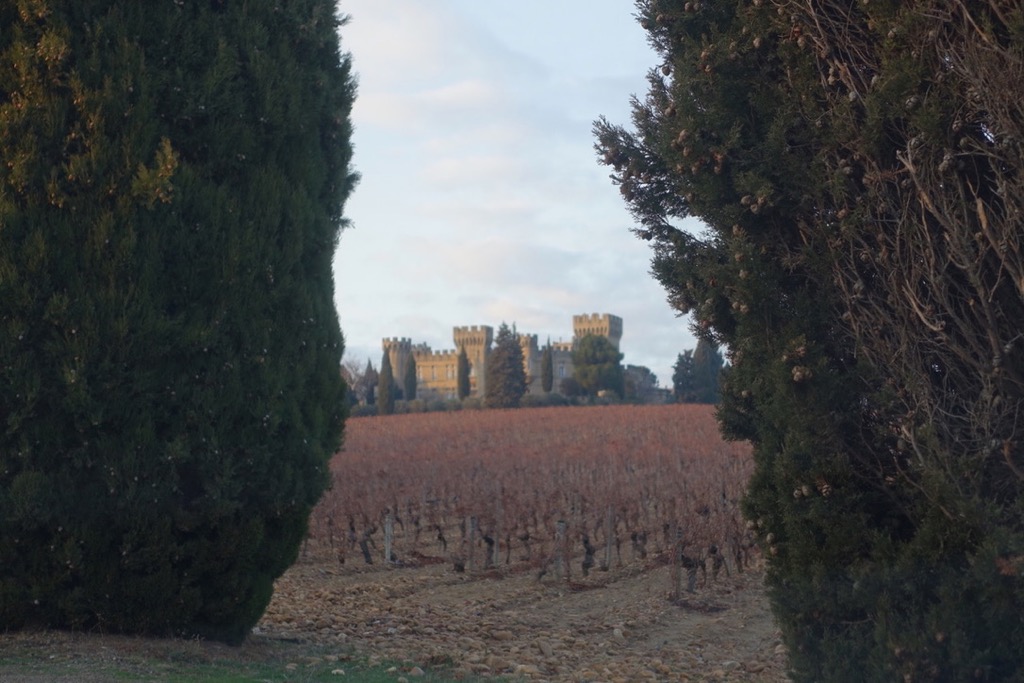
Time to settle in. The hotel is part of the wine estate Château des Fines Roches and leased by Martine and Laurent Zennaro who are the perfect hosts and make you feel at home. This castle sits in the middle of the Châteauneuf du Pape vineyards. Feel like a princess or prince out of a fairy tale story. |
Tasting at Domaine Mousset.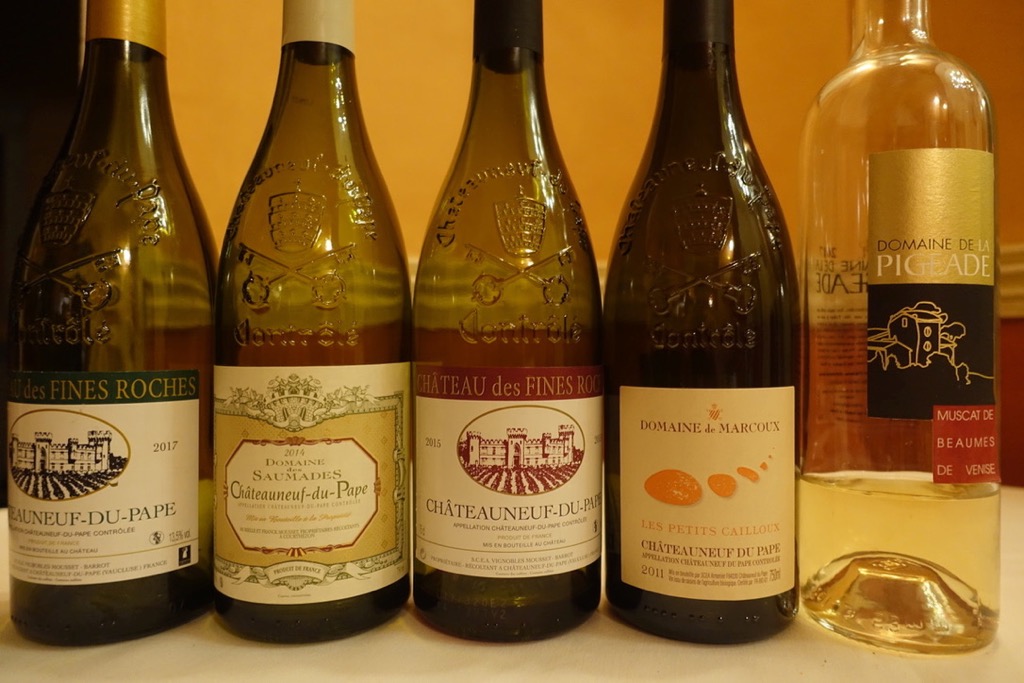
In 1936, Louis Mousset bought the fairy tale castle that is now home to the Hostellerie des Fines Roches. He also acquired 45 hectares of vineyards and made the property the center of his extensive wine business and the castle his family home. Today Louis seven grandchildren are major vineyard owners in Châteauneuf-du-Pape with eight wine estates: Domaine de Tout Vent, Domaine Fabrice Mousset, Domaine de la Font du Roi, Clos St. Michel, and Domaine des Saumades, under the umbrella of Domaine Mousset and Château du Bois de la Garde, Château Jas de Bressy, and Château des Fines Roches under the Vignobles Mousset-Barrot roof.
|
EVENINGWe will enjoy a four course wine pairing gourmet dinner in the beautiful restaurant of Château des Fines Roches.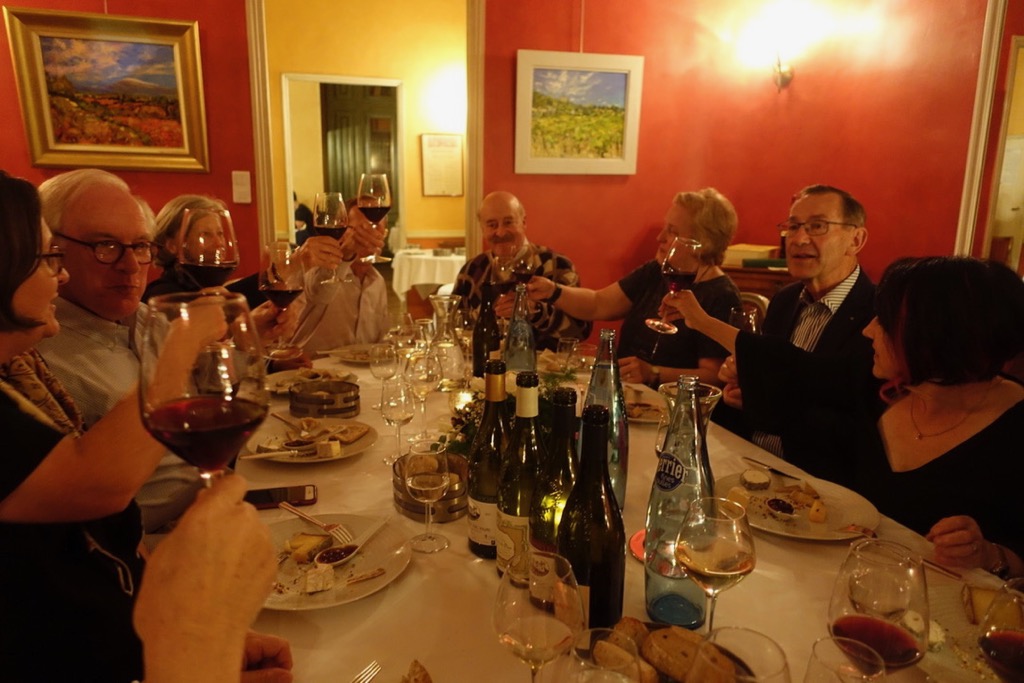
Chef Hugo Loridan-Fombonnet will prepare a special menu for us which is matched with wines of Château des Fines Roches. The wine estate Château des Fines Roches is one of 8 wineries of the Mousset family and owned by Catherine Mousset-Barrot. Its vineyard holdings of 130 acres lie entirely in the Châteauneuf du Pape appellation. This will be a special evening in a very special place and a fitting finale to our tour through the Rhône Valley. |
DAY 11: Wednesday, October 23 |
MORNINGBreakfast buffet at the hotel.This is our last activity together. After breakfast the tour ends.
|
LUNCHLunch on your own in the village of Châteauneuf du Pape.
Check out the small but famous village of Châteaunauf du Pape. There are many wine shops ‘caveau’ where you can taste wines – also right in the center of town you find the caveau of the Perrin family, owners of Château de Beaucastel. Lunch is on your own. |
AFTERNOONVisit of the ruins of the Summer Palace of the Popes
We drive up to the Pope’s summer palace that gave the village and vineyard appellation its name. Today we can only see the ruins of the medieval castle which sits at the top of the village and dominates the landscape to the south. It was built in 1320. The Popes of Avignon built their summer palace here to get away from busy Avignon. Only two walls and the foundation remain of the château. The walls are facing the village, and you see them from afar. They are still high and imposing, giving a good impression how it must have looked like centuries ago. |
EVENINGWe will enjoy a four course wine pairing gourmet dinner in the beautiful restaurant of Château des Fines Roches.
Chef Hugo Loridan-Fombonnet will prepare a special menu for us which is matched with wines of Château des Fines Roches. The wine estate Château des Fines Roches is one of 8 wineries of the Mousset family and owned by Catherine Mousset-Barrot. Its vineyard holdings of 130 acres lie entirely in the Châteauneuf du Pape appellation. This will be a special evening in a very special place and a fitting finale to our tour through the Rhône Valley. |
DAY 11: Wednesday, October 23 |
MORNINGBreakfast buffet at the hotel.This is our last activity together. After breakfast the tour ends.
|














